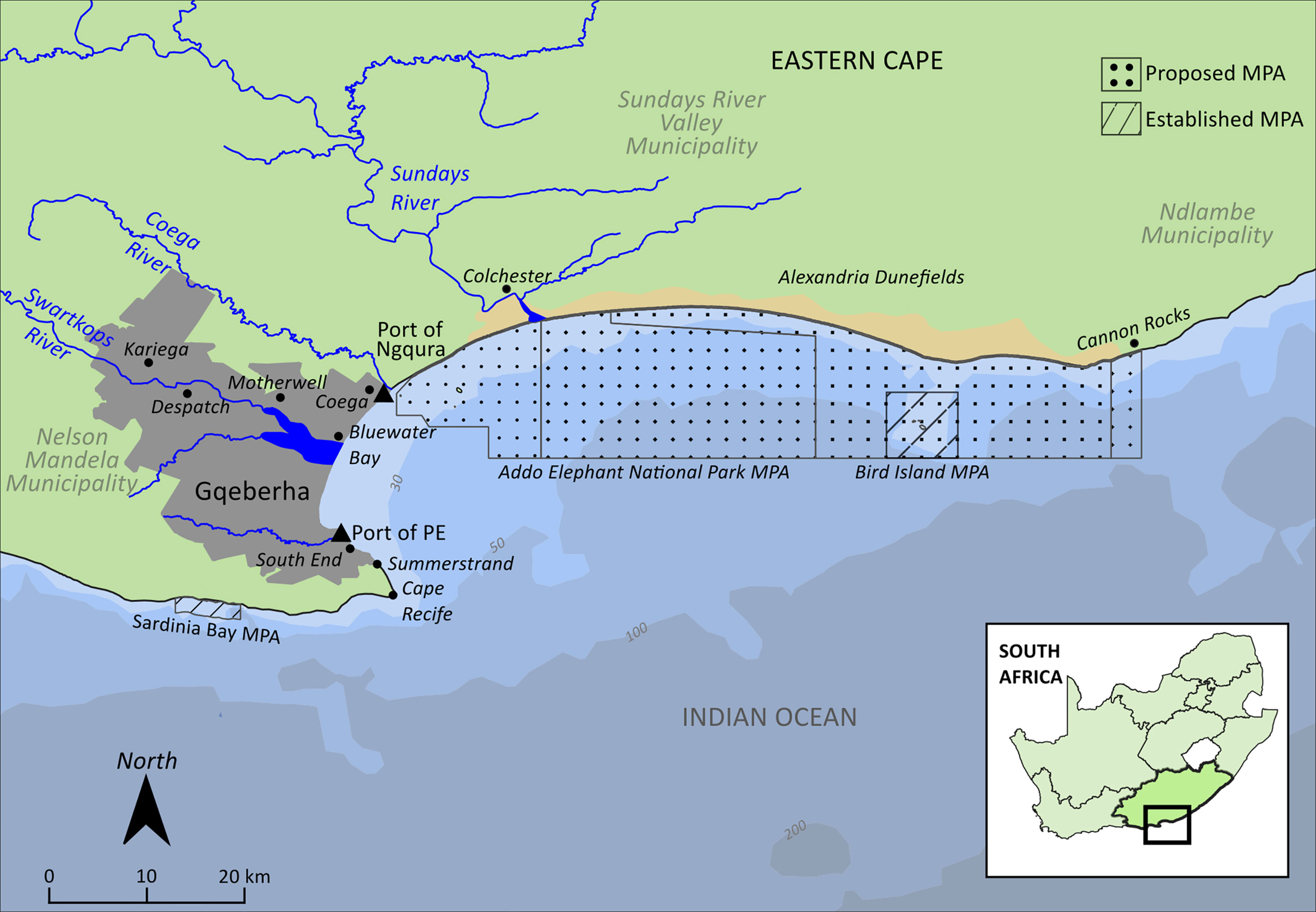- 1Department of Development Studies, Institute for Coastal and Marine Research, Nelson Mandela University, Gqeberha, South Africa
- 2One Ocean Hub, Law School, University of Strathclyde, Glasgow, United Kingdom
Current ocean management approaches are often characterised by economic or environmental objectives, paying limited consideration to social and cultural dimensions, as well as Indigenous and local knowledge. These approaches tend to inhibit ocean stewardship, often marginalising coastal communities or limiting people’s access to spiritual, traditional and recreational uses of the ocean and coast. Piloting arts-based participatory research methods to co-create knowledge with co-researchers in Algoa Bay, South Africa finds that these methods can be useful in highlighting cultural connections to the ocean, and remembering and imagining, or reimagining, ways in which people relate to and care for the ocean and coast. For example, using photography and in situ storytelling often allows people to convey memories and histories of more accessible coastlines, or envisaging a future with more inclusive and participatory ocean management. The study finds that there is a strong sense of exclusion from and lack of access to coastal and ocean areas in Algoa Bay where Indigenous and local communities have depended on for spiritual, cultural and recreational purposes for several generations. Co-creation of knowledge regarding connections, values and priorities of the coast and ocean with Indigenous and local communities should therefore be planned for before the implementation of integrated ocean management approaches and intentionally designed as part of adaptive management processes. Emphasising these cultural connections, and better recognising them in ocean management has the potential to include i people’s awareness of the ocean which could translate into an increased sense of care and stewardship towards the ocean and coast as people feel more connected to their contextual seascapes. This could in turn contribute to a more sustainable sociocultural approach to ocean management which is necessary for equitable and sustainable future ocean social-ecological wellbeing.
1 Introduction
Our ocean is facing several environmental challenges such as pollution, biodiversity loss, acidification and damaging fishing practises, alongside climate change impacts such as global warming and sea-level rise (Rudolph et al., 2020). Current approaches to ocean management remain limited in their scope, reach and inclusivity (Rudolph et al., 2020; Saunders et al., 2020; Muhl and Sowman, 2020). These shortfalls are sometimes recognised to be related to the lack of attention to sociocultural aspects of people’s relationship to the ocean and coast, and the prevalent idea that we as humans are separate and dominant to the natural world around us. In this paper ocean stewardship is defined as the actions people take to, or sentiments people have towards, responsible use and care for the ocean and coast (Bennett et al., 2018), whilst ocean management is defined as decision-making regarding a specific marine area within a country’s exclusive economic zone (EEZ). The paper argues that the above shortfalls are related to a misalignment between ocean management and people’s sense of ocean stewardship, where a reimagining of the latter through arts-based participatory approaches can highlight ways in which local and Indigenous communities connect with and therefore care for the ocean and coast. These connections have the potential to transform ocean management to ensure it is contextually relevant, inclusive and encourages relationships of care and respect by people towards their oceans and coasts.
There is a recognised lack of research on the social and cultural dimensions of current ecological challenges facing our ocean, and sociocultural interactions with coastal environments remain poorly understood (Poe et al., 2013; Satterfield et al., 2013; Gee et al., 2017; Saunders et al., 2020). In this paper social dimensions refer to aspects of life such as welfare, livelihood, health and community relations, whilst cultural dimensions refer to values, beliefs, worldviews, practices, assets and processes such as language, rituals, stories, sites, and ‘collective understandings that enable social life’ (see Appadurai, 1996; Satterfield et al., 2013; Winthrop, 2014; Gee et al., 2017). It is important to note that both are dynamic and ever changing. As emphasised by Gilek et al. (2021), marine spatial planning (MSP) practice and research continues to be ‘dominated by blue economy and environmental concerns’, often neglecting social sustainability needs. This is equally true of other integrated ocean management approaches, such as marine protected areas (MPAs), where research show there is a lack of consideration given to social and cultural dimensions, values and beliefs, as opposed to economic and ecological dimensions and priorities (see Berkes, 2015; Christie et al., 2017; Muhl and Sowman, 2020). Social sustainability is closely linked to concepts of social justice, and central to the concept is the recognition of sociocultural diversity (Saunders et al., 2020), highlighting livelihoods, rights and wellbeing of Indigenous and vulnerable communities (Elwell et al., 2018).
These arguments and research findings are not new, but despite the growing emphasis on greater inclusion in marine governance and research, influential and top-cited marine research continues to exclude scholars from African institutions (Maas et al., 2021; Schipper et al., 2021),1 and marine governance perpetuates top-down management without adequate and sincere collaboration with the people most impacted by coastal and marine management decisions (Sowman and Sunde, 2018). Failing to properly recognise the cultural dimensions of the ocean can hinder collaborative management, reduce trust and reproduce social inequalities within ocean governance (Gee et al., 2017). Current area-based ocean management approaches tend to inhibit ocean stewardship by local and Indigenous communities by either intentionally or unintentionally marginalising coastal communities or creating conflict between ocean users (see Sowman and Sunde, 2018; Muhl and Sowman, 2020). This is why ocean and coastal stewardship and management needs to be reimagined and realigned. This study therefore set out to explore how arts-based participatory methods with residents of Algoa Bay, South Africa, could identify Indigenous and local knowledge that should be better ‘seen’ and ‘heard’ for more inclusive ocean governance.
2 Literature Review
2.1 Sociocultural Dimensions in Ocean Governance
Recognising that culture impacts everything we do, think, say and write (Said, 1993), and that culture plays an integral role in existing ocean management strategies and processes, this paper calls for an increased debate on what particular culture is defining and influencing current ocean stewardship practices, such as cultures of care, capitalism, conservation and co-existence, or cultures that underpin Blue Economy or conservation agendas. In a paper discussing the importance of a transition towards transformative change in ocean governance, Rudolph et al. (2020) emphasise the limitations of current ocean governance strategies in addressing complex social-ecological challenges and argue that we need to move towards a global approach to ocean governance that recognises it as a commons (‘a non-state, non-private shared resource’) to improve ocean stewardship. Without going in-depth about how and what cultures impact upon and are impacted by ocean governance, Rudolph et al. (2020) argue that transformative change requires a shift in culture away from ‘consumerism, marketization, (national) self interest and growth’ towards ‘values, frames and worldviews of well-being, sustainability and global commons’.
In this paper we move beyond the understanding of the ocean as a commons and argue that we need to learn from people and communities that have co-existed with their environment for centuries and recognise the ocean as part of our ecosystem. Rather than focusing on the ocean and coast as a repository of resources, we need to celebrate and respect the gifts that we receive from ocean life through its diverse ecosystems as well as acknowledge the interconnectedness between humans and nature. As poignantly articulated by Alexis Pauline Gumbs (2020) in her book Undrowned: Black Feminist Lessons from Marine Mammals, we need to engage in ‘undoing a definition of the human, which is so tangled in separation and domination that it is consistently making our lives incompatible with the planet’. Chilisa (2019) highlights how postcolonial Indigenous cultures often hold a worldview that recognises the ‘interconnectedness and interdependence of all things’ and the integration of values, beliefs, connections and experiences in what one recognises as reality. In South Africa specifically, Bam (2021) emphasises how Khoisan communities sometimes continue to practise environmental stewardship based on interdependence and co-existence. Learning from Indigenous and local communities to reimagine ocean stewardship can therefore be essential.
2.2 Indigenous and Local Knowledge Integration
One way of addressing the inclusion of sociocultural dimensions and recognising social sustainability for integrated ocean management is increasing representation of different knowledge systems in ocean governance and making sure Indigenous and local knowledge systems (ILKS) are informing management approaches and processes. Although the importance of integrating ILKS in ocean management is emphasised in recent literature (see Flannery et al., 2018; Okafor-Yarwood et al., 2020; Saunders et al., 2020; Williams et al., 2020), how to best do this remains unclear (see Strand et al., 2022, forthcoming).
In this paper, Indigenous knowledge is defined as values, beliefs and culture that have been handed down through generations, often by word of mouth, practices, rules and traditional rituals, and that is unique to a culture or a specific people group (see Gadgil et al., 1993; Grenier, 1998). As emphasised by Grenier (1998), it is knowledge that is often stored and expressed through cultural values, myths, proverbs, beliefs, agricultural practises and material artefacts. In the South African context this includes, among others, hunting, fishing and gathering practises, rituals, healing and traditional medicine, rules, histories and cosmology (Barnard, 1992). In and around Algoa Bay, the Sangoan people group, ancestors to Khoe and San Indigenous communities, settled at least 100,000 years ago. Approximately 8,000 years ago Nguni communities, ancestors to the amaXhosa and amaZulu communities among others, arrived in the Bay and settled along the rivers and coast.
One of the reasons for referring to Indigenous and local knowledge systems is to make explicit that in South Africa there is a blending or merging of cultural values, kinship and practises between Indigenous Khoi and San, the amaXhosa, amaZulu, and other ethnic groups of South Africa such as the Cape Malay, Indian, Dutch, Afrikaans and English communities that have settled in and around Algoa Bay since the early 1500s (Carstens 1966; Bernard, 2010). Carstens (1966) refer to this process as ‘acculturation’, arguing that Indigenous identity groups such as the Korana and Khoekhoe were ‘largely subsumed’ under Cape Nguni communities or the apartheid category of ‘Coloured’ (Bernard, 2010). Therefore, in the context of Algoa Bay, the lines between Indigenous and local traditions, knowledge and cultural heritage connected to the ocean and coast that have been handed down through generations are oftentimes blurred and cannot be neatly categorised and said to belong to a single grouping of people. Although these knowledge systems are vital to inform past, present and future interactions with the ocean and coast, this knowledge is seldom represented or integrated in ocean governance. In this paper local knowledge also refers to recreational use and connections to the ocean and coast, such as diving, fishing, surfing and swimming.
2.3 The Case Study: Algoa Bay, South Africa
The study is situated in Algoa Bay, Eastern Cape Province, South Africa, stretching from Cannon Rocks in the east to Sardinia Bay in the west (see Figure 1), which is the first pilot site to inform the national MSP framework (Dorrington et al., 2018). The Bay is recognised as ‘internal waters’ within the territory of South Africa2, meaning that any decision-making should follow all domestic legislation such as laws regarding maritime resources (Marine Living Resources Act, 1998), environmental management (National Environmental Management Act, 1998; Integrated Coastal Management Act, 2008) coastal activities on land (Spatial Planning and Land Use Management Act, 2013), underwater cultural heritage [National Heritage Resources Act (NHRA), 1999], alongside the MSP Act of 2018, aiming to provide a framework for MSP through the development of marine area plans (Dorrington et al., 2018; Rivers et al., 2022). Provincially, conservation authorities such as the Eastern Cape Parks and Tourism Agency (ECPTA) and South African National Parks (SANParks) manage nature reserves and MPAs alongside the relevant departments at provincial, district and municipal level. In Algoa Bay, the Nelson Mandela Bay Municipality (NMBM) manages areas spanning from Sardinia Bay to Colchester, whilst areas east of Colchester to Cannon Rocks are managed by the Sundays River Valley Local Municipality.
The study engaged with Indigenous and local community representatives to co-create knowledge that can inform the MSP process in Algoa Bay through the Algoa Bay Project, aiming to develop an integrated, ecosystem-based approach that considers all stakeholders and sectors (Dorrington et al., 2018). The study piloted arts-based participatory research (ABPR) methods in the form of photography and storytelling. This knowledge co-creation process sheds light on problems with current ocean management and provides responses and alternative approaches to ocean conservation and management. The process also highlights dreams of a different future, looking back to pre-apartheid and sometimes pre-colonial memories and histories, Indigenous concepts of co-existence and current mechanisms of ocean stewardship that can be better included by planners, conservation agencies, decision-makers, and researchers.
2.4 Knowledge Co-Creation
Knowledge co-creation, or knowledge co-production, is the coming together of different actors (knowledge holders) in the social-ecological system to generate new knowledge or renewed approaches to a specific problem. Depending on your discipline or school of thought the concept might change, but in sustainability research and environmental management, knowledge co-creation is often thought of as a process that ‘seeks to connect researchers with diverse societal actors to collaboratively and iteratively produce knowledge, action and societal change’ (Chambers et al., 2021), or that ‘brings together Indigenous People’s knowledge systems and science to generate new knowledge and understandings of the world that would likely not be achieved through the application of only one knowledge system’3 (Yua et al., 2021). Knowledge co-creation aims to shift inherent power imbalances in academia and research more broadly and challenge the coloniality of methodologies (see Smith, 1999; Chilisa, 2019).
It is important to note that this paper does not seek to represent Indigenous and local knowledge in its entirety that should be integrated in ocean management. Instead of focusing on ‘integrating’ different knowledge systems into decision-making processes, and impact management processes in other contexts or on a broader scale, this study is rather aiming to reimagine ocean management in a very specific context as informed by local residents and managers. Knowledge holders therefore keep their own knowledge outputs but inform critiques of current ocean management and ways to better co-create knowledge for more inclusive ocean management processes in the future. Recognising that knowledge, culture and governance are all intertwined and interdependent (Latulippe and Klenk, 2020), this study rather aims to highlight what knowledge systems and cultures are currently informing and guiding ocean management, and encourage creative spaces to reconceptualise, reimagine and even remember more inclusive, interdependent and socioculturally sustainable approaches to ocean stewardship. The use of arts-based approaches has been significantly useful here.
3 Materials and Methods
The methods section outlines the use of contextualised ABPR methods in the form of photovoice and digital storytelling where Indigenous and local community representatives are recognised as co-researchers. The emphasis here is on participatory methods, which involves responsive design where the objectives, knowledge sharing and data collection methods are revised together with research participants (hereafter referred to as ‘co-researchers’)4 throughout the study duration (Minkler and Wallerstein, 2008). Participatory research often recognises the subjectivity of knowledge creation more broadly and seeks to form research partnerships with co-researchers to collaboratively approach a problem at hand (Leavy, 2017). As highlighted by Minkler and Wallerstein (2008), the goals of participatory research methods often include 'analysing personal lives in relation to the structures (both overt and hidden) that might control people’s lives; celebrating strengths and agency, not just emphasising victimisation; working for goals of social justice; and undermining the notion of the objectivity of science’. Participatory research design often includes social learning processes,5 and as the aim of this study is to co-create knowledge, it is imperative that the research approach is collaborative, flexible, iterative and dynamic. The specific research questions this study set out to answer are i) what is the usefulness of arts-based methods to identify and convey relevant Indigenous and local knowledge, and; ii) how can we better integrate this Indigenous and local knowledge into area-based ocean management in Algoa Bay?
3.1 Arts-Based Methods
Arts-based methods can be understood as knowledge production processes where art forms such as music, photography, craft, poems and drawing play a significant role in communicating experiences, thoughts, ideas, values, beliefs and knowledge (Barone and Eisner, 2012). Arts-based approaches to knowledge creation are often used when the objective of the study is to ‘explore, describe, evoke, provoke, or unsettle’, making it most relevant to a qualitative inductive study that aims to explore how ILKS can better inform ocean and coastal management in Algoa Bay (Leavy, 2017).
Arts-based methods have been found useful in sustainability research when it comes to encouraging creative innovation and thinking (Galafassi et al., 2018), conveying ‘alternative’ or omitted stories and narratives (Foster, 2016; Capous-Desyllas and Morgaine, 2018) and balancing out power dynamics between researchers and research ‘participants’ (Castleden et al., 2008; Leavy, 2020). For example, from research with Indigenous First Nation communities in Canada, Castleden et al. (2008) find that employing photovoice as a community-based participatory research approach addressed issues of injustice and inequality whilst fostering trust and building capacity. Working with community representatives, scientists, practitioners and government representatives in Kenya and Mozambique, Galafassi et al. (2018) experienced that storytelling was useful in imagining innovative solutions to more sustainable social-ecological systems. In this study, one of the aims has been to ensure that knowledge holders remain owners of their own knowledge throughout the research process using arts-based methods such as photography and storytelling.
The combination of photography and storytelling, where co-researchers take photographs to explore, explain or understand a particular issue and retain the power to explain the underlying or interrelated meaning of this photograph, can be referred to as photovoice, photo novella or reflexive photography (Castleden et al., 2008). The photographs, or the process of taking the photographs, can function as a ‘catalyst’ for dialogue on important issues of social change (Castleden et al., 2008), such as improved recognition of ILKS in ocean management processes (see Strand et al., 2022, forthcoming). Storytelling, in and of itself, is known to support knowledge holders in controlling the storyline and processes of self-representation and is often used when working with sacred or sensitive knowledge and narratives (Prins, 2004; Powell et al., 2007).
3.2 The Research Steps
Recognising that ABPR have been found to support the process of identifying, recognising and analysing different ways of knowing the ocean and coast and culturally significant areas, this section expands on the knowledge co-creation steps that could inform MSP in Algoa Bay. These steps included initial workshops with ILKS holders to shape the research objectives, training workshops in photography and recording audio stories using smartphones, field visits to sites of cultural significance to take photographs and record stories in-situ, collaborative analysis workshops to identify common themes and knowledge that should be recognised in decision-making, a public exhibition where co-researchers present their final photographs and stories, and finally a multi-stakeholder workshop with local managers to explore pathways to integrate ILKS in areas-based ocean management processes.
3.2.1 Step 1 - Outreach and Shaping Workshops
Initial shaping workshops were organised with Indigenous leaders and representatives, small-scale fishing representatives, research organisations and local residents of Algoa Bay. These workshops were organised following systematic outreach to different knowledge holders and community representatives that had already been involved in the Algoa Bay Project to explore who might have not been adequately engaged during the initial stakeholder engagement processes. The shaping workshops were organised both in person and virtually to accommodate people that could not work virtually, and to make sure that the space was conducive to roundtable discussions and brainstorming. Translators were present at the initial and subsequent workshops, ensuring that residents and co-researchers could share or understand information in their preferred language, which were often isiXhosa or Afrikaans.
These workshops discussed the initial idea about the research project, what redefined or alternative objectives could be, what knowledge some residents might want to share, and identified possible co-researchers that had important Indigenous and local knowledge of the coast that should inform management processes. These workshops also found that some direction was needed in terms of discussing the specific research methods and that many people were interested in participating in the study. Specifically, these workshops found that Indigenous knowledge holders, subsistence fishers, women and youth were often excluded from decision-making for area-based ocean management. The study therefore intentionally included co-researchers from these groups.
Following the broad definition of ILKS, purposeful snowball sampling from the initial outreach and shaping workshops, the final 24 co-researchers in this project include representatives of Khoisan communities, subsistence fishers and bait collectors, youth, spiritual leaders and recreational ocean users, all current residents in Algoa Bay. The co-researchers were carefully approached, usually through Whatsapp, with textual and visual outlines of the proposed study to take part in the project. Co-researchers were invited to the first workshop without any obligation to take part in the rest of the study, and were continuously asked to affirm their consent prior, during and following the field visits and sense-making workshops (see Step 4). The final group of co-researchers purposefully included 50% self-identifying women, and 20% youth between the ages of 15 and 20 as they are often omitted from knowledge creation processes even though they have the largest stake in how the future unfolds in terms of climate change threats and sustainability risks (Sweeney and Morgera, 2021).
3.2.2 Step 2 - Cross-Learning Workshops
Once the co-researchers had confirmed their interest in partaking in the study, the first arts-based learning workshops were organised according to people’s schedules and availability. These learning workshops delved deeper into the objectives of the study and created a space for everyone to introduce themselves and their connections to the ocean and the coast. The learning workshops were centred around cross-learning, where co-researchers shared their expertise and experiences with the coast, and a photojournalist and podcaster shared expertise and experiences about conveying knowledge, stories and connections through photographs and storytelling using smartphones. The learning workshops found that unlearning is just as important as learning (see Strand et al., 2022, forthcoming), and that the processes of listening and slowing down (see Bhabha, 2005) are central to facilitating conducive cross-learning spaces. While co-researchers were free to use a variety of methods to share, express and convey their connections to the ocean and coast, everyone subsequently decided to take photographs and record stories for a multi-media exhibition.
3.2.3 Step 3 - In Situ Photography and Storytelling
Following the cross-learning workshops, which also included practising the use of smartphones for audio recording and photography, the principal researcher (MS) accompanied co-researchers to their site or sites of choice. In some instances, co-researchers would take photos and record themselves using the smartphones, whilst in other instances co-researchers would highlight scenes, areas or objects for the principal researcher to take pictures of, and share their stories whilst in recorded conversation with the principal researcher. Co-researchers shared and recorded their stories in different languages, including English, isiXhosa and Afrikaans, which were later transcribed and sometimes translated by translators.
These in situ processes of photography and storytelling require a significant amount of time, slowness and flexibility (Strand et al., 2022, forthcoming), but are very important to recognise the contextuality of knowledge and location-specific connections, values and relationships. On average, the in situ photography and storytelling took a day or two to organise, and a full day in the place or places of choice with each co-researcher.
3.2.4 Step 4 - Sense-Making Workshops
Finally, after organising field visits that involved conversations around past, present and future connections to one or more specific places along the coast, often taking photographs recording stories, experiences and narratives, sense-making workshops were organised to get co-researchers together to discuss the knowledge products, the experience of developing these, and what they might mean in a broader ocean management context in Algoa Bay. Following the transcription of the stories, and sometimes translation of stories in Afrikaans and isiXhosa, and reviewing all the photographs, the principal researcher identified common themes emerging from the stories, narratives and photographs. These themes, which included ‘subsistence, income and food’, ‘spiritual and religious connections’, ‘history and culture’, ‘activities, fun and family time’, ‘aesthetics, beauty and wonder’, ‘sense of calm and peace’, and ‘learning’ were then presented to the co-researchers to see which, if any, resonated with them, if any other themes needed to be added and if some needed to be re-conceptualised.
Prior to and following these sense-making workshops, depending on their availability, co-researchers also reviewed all their own photographs to highlight their favourites, if any. Each co-researcher had the opportunity to select four of their favourite or most meaningful photographs to exhibit. These were selected through individual conversations in-person, on whatsapp and phone calls between the principal researcher and the co-researchers, including inputs from the assisting curator when co-researchers were unsure what photographs they wanted to exhibit. Participatory mapping exercises were also carried out during these sense-making workshops. Co-researchers were asked to mark areas of cultural significance on an A1-sized printed map of Algoa Bay. Different coloured markers signified different relationships with the ocean and coast, as recognised by the final themes identified by co-researchers following the initial discussions, which included the initial themes in addition to ‘mental health and wellbeing’ and ‘possible future uses and connections’. This process of participatory mapping resulted in discussions around the overlapping uses and significance of many places and areas, how to best manage such areas, the role of stewardship, particularly the ways in which people currently cared for the oceans and coast, and how residents could and should be further involved in decision-making in the future.
The research process of co-producing knowledge on indivudials’ relationship to the ocean and coast in Algoa Bay took more or less 12 months, including the multimedia exhibition and multi-stakeholder workshop. The former exhibited four photographs with accompanying snippets of stories as well as audio recordings of each co-researcher (96 photographs in total), whilst the workshop brought together the co-researchers as well as local municipal coastal managers and representatives from relevant authorities such as MSP, conservation, heritage and industry management to explore pathways to acknowledge and recognise this knowledge in future ocean management. Whilst this paper outlines steps 1-4, these further steps will be reported on in future publications.
3.3 Ethics
This study has institutional ethics clearance from Nelson Mandela University. Co-researchers were approached prior to the study with both verbal and written information about the study process, timeline and planned engagements. All workshops and engagements were conducted with informed consent (ethics number H21-BES-DEV-007).
4 Results
The results of this study can be divided into three interconnected findings. Firstly, the initial outreach, shaping and cross-learning workshops highlighted a strong sense of exclusion from and lack of access to coastal and ocean areas where Indigenous and local communities have depended on for spiritual, cultural and recreational purposes for generations. Secondly, the in situ storytelling and photography identifies themes of cultural, spiritual and traditional connections to the ocean and coast. These connections and values are often in conflict with current economic and environmental priorities in the Bay, at least when it comes to the significance of specific areas and places. Finally, this study finds that the use of ABPR allows for remembering the past and imagining more inclusive futures where local communities have more of a say in the stewardship of their coast and ocean. In each section we suggest ways in which ocean management could be reconceptualised or reimagined.
4.1 Exclusion and Lack of Access to the Ocean and Coast
In initial outreach, scoping and learning workshops, themes of exclusion, lack of access and a sense of loss when it comes to ocean and coastal connections and practises were identified. For small-scale or subsistence fishers6 this often involves strict permit regulations or closed off stretches of coast, estuaries or rivers. For Khoisan co-researchers this sometimes means fenced-off areas, nature reserves and paywalls where there are sacred historical heritage sites, ancient Khoisan fish traps or places along the coast that are important for ceremonies, rituals or specific events that they are unable to access. The fact that you have to pay to access some beaches, coastal areas and river banks, that there are fenced-off areas such as mostly white, higher income earner areas that have private properties that extend all the way to river banks or industrial development zones reminds the co-researchers of institutionalised racial segregation during colonialism and apartheid. These paywalls and physical barriers to the ocean continue to limit access to learning, recreational use and building further connections to the ocean and coast for themselves, their families and communities (see Figure 2).
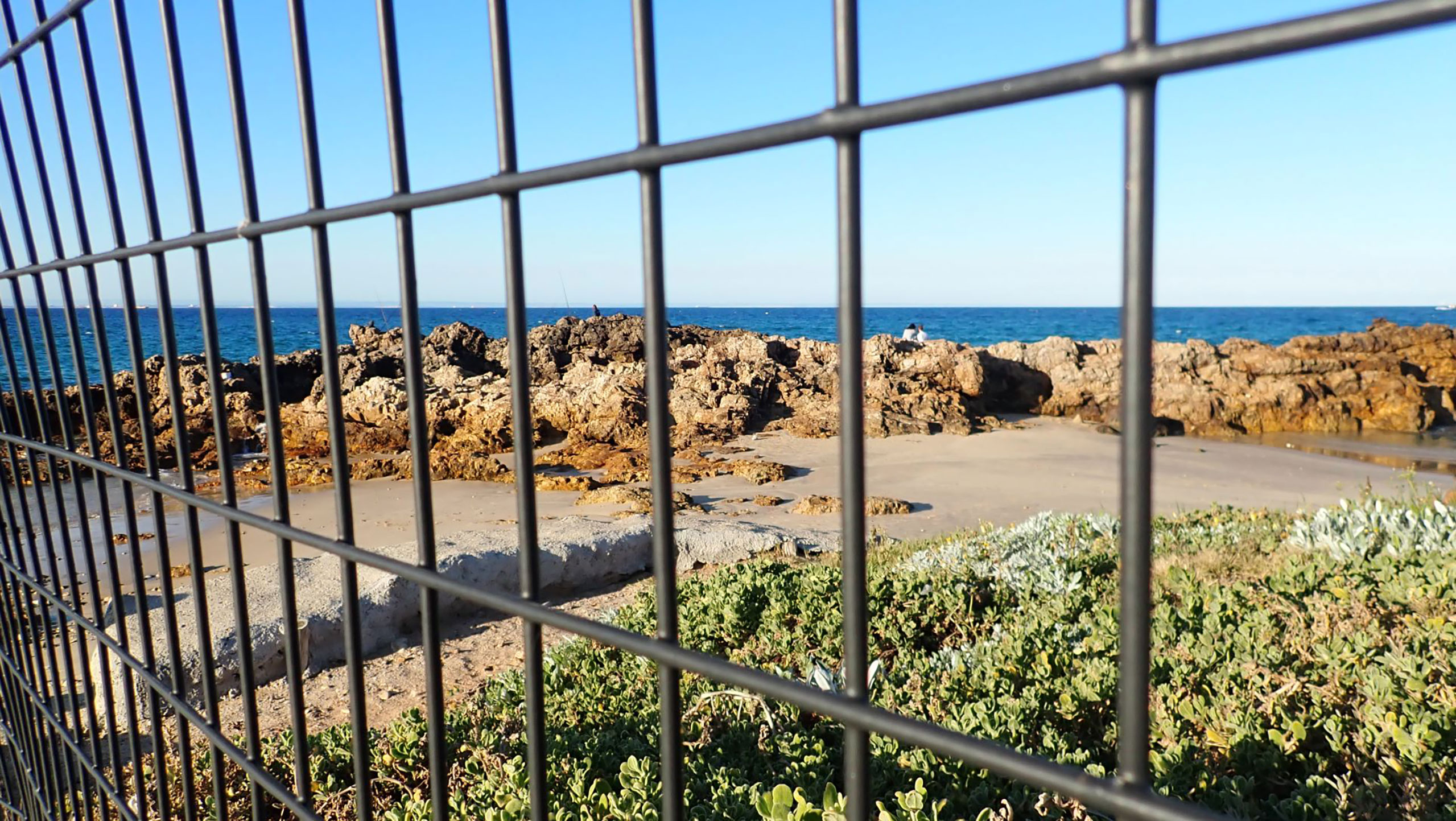
Figure 2 Photograph of a beach in Algoa Bay with a fence in front of it. Many areas are now fenced off for people to use, often with expensive paywalls.
“It would be nice if everybody could have access to the ocean. I feel like it is not fair that they ask money at the gate because every human being is supposed to be part of this” (Resident of Colchester community Bradley Links, 2021).
For several co-researchers the physical and violent experience of forced removals during the apartheid Group Areas Act (1950) from places on or close to the coast were part of their own or intergenerational experience. In particular, one co-researcher had personally experienced forced removals twice. First from the coastal area between Cape Recife and Sardinia Bay known to some as ‘the wild side’, to a residential area in the city of Gqeberha (formally Port Elizabeth) near the harbour called South End, and then from South End to the Northern Areas, which are even further away from the coast and ocean. Furthermore, scoping workshops also highlighted co-researchers’ exclusion from decision-making about the ocean and coast, therefore diminishing people’s sense of relevance and importance when it comes to managing areas of which they depend on for subsistence, livelihood, spiritual, cultural, recreational, heritage, physical, mental, historical, religious, educational and generational-related reasons (see Figure 3).
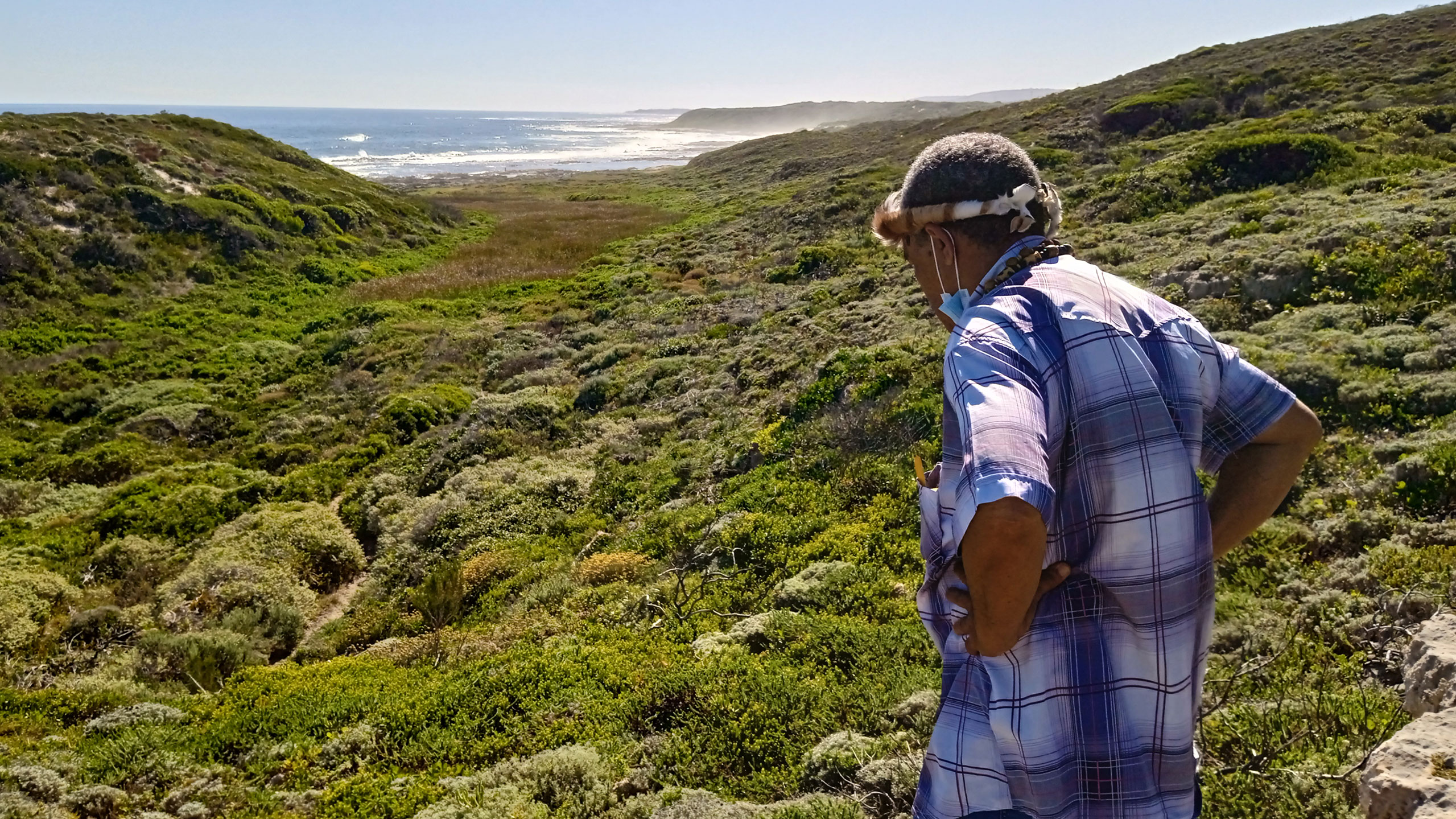
Figure 3 Picture of Paramount Chief Human of the Kei Korana tribe in the Eastern Cape, looking out over what used to be areas where the Indigenous Khoi and San people lived.
“The Group Areas Act has driven us far away from the sea. We live in the Northern Areas now and transport is expensive. There are a lot of expenses to come to the sea. You must buy food, you must pay for the petrol to bring you here, and you must pay to enter. It is no longer free for us to enter. It is privatised, which is making it difficult for us, for the first Indigenous peoples of South Africa, to translate our culture and our heritage to our children’s children” (Paramount Chief Human of the Kei Korana 2021).
The lack of representation in decision-making for ocean management brings us back to the question of which cultures and priorities are currently informing management approaches, strategies and objectives in South Africa, and which cultures are not. Trouillot (1995) highlights the importance of scrutinising whose narratives inform the history we are presented with and paying attention to whose narratives might have been omitted or silenced in the process. Similarly with culture and ocean management, we need to scrutinise what and whose culture, values and worldviews have been omitted and excluded from current ocean management processes in a post-apartheid context. In the context of Algoa Bay, subsistence fishers argue that their experiences have been excluded from estuary management in the Swartkops Estuary.
“The problem that we are facing is that the river is being polluted and it is really affecting us in our community in Aloes further up the river. But they don’t listen to us that side. It’s been an ongoing battle... They are not even trying to make a plan with the polluted water coming from the Markman side not to enter into the river” (Subsistence bait collector and fisher from Aloes 2021).
Similarly, Indigenous cultural heritage in the form of physical ancient stone-walled fish traps and shell middens7 in a local nature reserve (Cape Recife) seem to be downplayed in the coastal management of the area, and residents recreational and historical relationships to parts of the coast in a local industrial development zone (Coega Development Zone) have been largely omitted. Some residents are continuously denied access, either through physical or financial barriers, to areas along the coast in Algoa Bay for environmental or economic reasons, without enough consideration to how their relationship and connection to the coast might actually align with current management objectives.
“This area is where our traditions were done. All our tradition is done nearby waters, mostly by the ocean. So it is very important that the ocean is open for us to do our rituals. The ocean is like a god in itself. It will talk to you. That is why we do rituals here. We have a connection to the ocean. The ocean also cleans you. When you go home, you will feel free. Now this coast here is off limits for us, which is making us very sad” (Khoisan spiritual healer Chrissila Billings 2021).
Rethinking ocean management with the co-researchers identified several alternatives to current approaches, like involving Indigenous and local knowledge holders on management committees to inform important events, rituals and practices where people should gain free access to the nature reserve or beach, provided that they leave sites as they found them. In situ storytelling and sense-making workshops highlighted the opportunity of removing paywalls for neighbouring communities, such as with the example of the Colchester community and access to the Sundays River Estuary. Traditional means of fishing and harvesting should be allowed within specific seasons, and Indigenous chiefs and communities should be in charge of restoring and maintaining ancient fish traps such as the ones found at the Cape Recife nature reserve (see Figure 4). Another approach that emerged from the sense-making workshops was to better map and safeguard people’s cultural uses and connections to the ocean and coast, to ensure that these are not threatened by pollution from potential oil and gas developments, bunkering, shipping and commercial fishing.
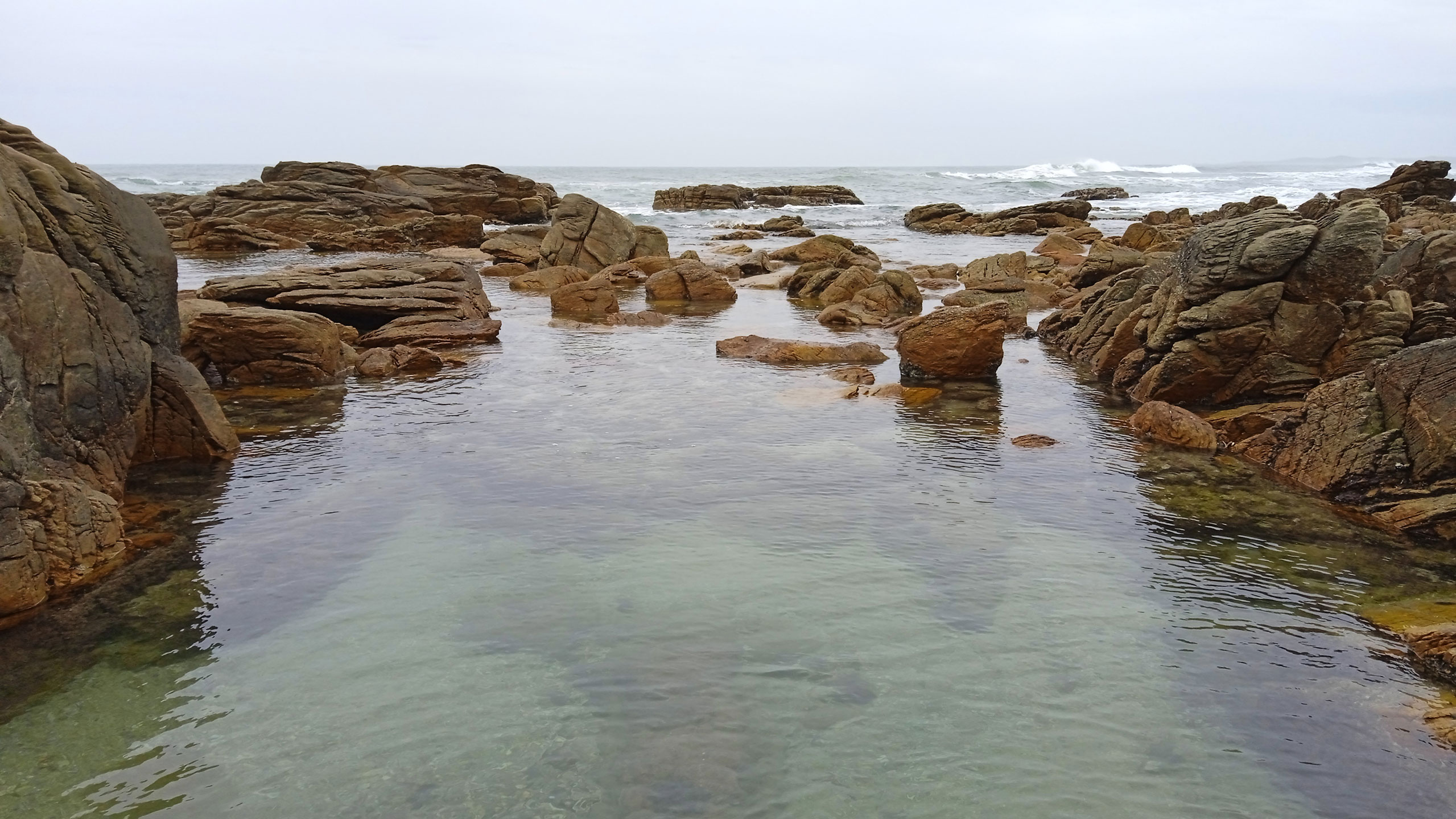
Figure 4 A gully in the Cape Recife Nature Reserve where ancient fish traps exist, which is fenced off and requires people to pay to enter by car.
4.2 Spiritual, Cultural, Emotional and Physical Connections to the Ocean and Coast
The arts-based methods also highlighted that ocean stewardship is closely related to people’s spiritual, cultural, emotional and physical connections to the ocean and coast. Co-researchers want to take care of the ocean and coast and have a stronger say in their management because they have both intrinsic (an end in itself) and instrumental (a means to an end) value to them. Investigating Indigenous and local knowledge of the ocean and coast in Algoa Bay continuously highlights these cultural connections and their importance in everyday lives for wellbeing, identities, belonging, community, heritage and spirituality. For example, for many co-researchers from Nguni communities and traditions the ocean is sacred as it is the home of their ancestors (see Figure 5).
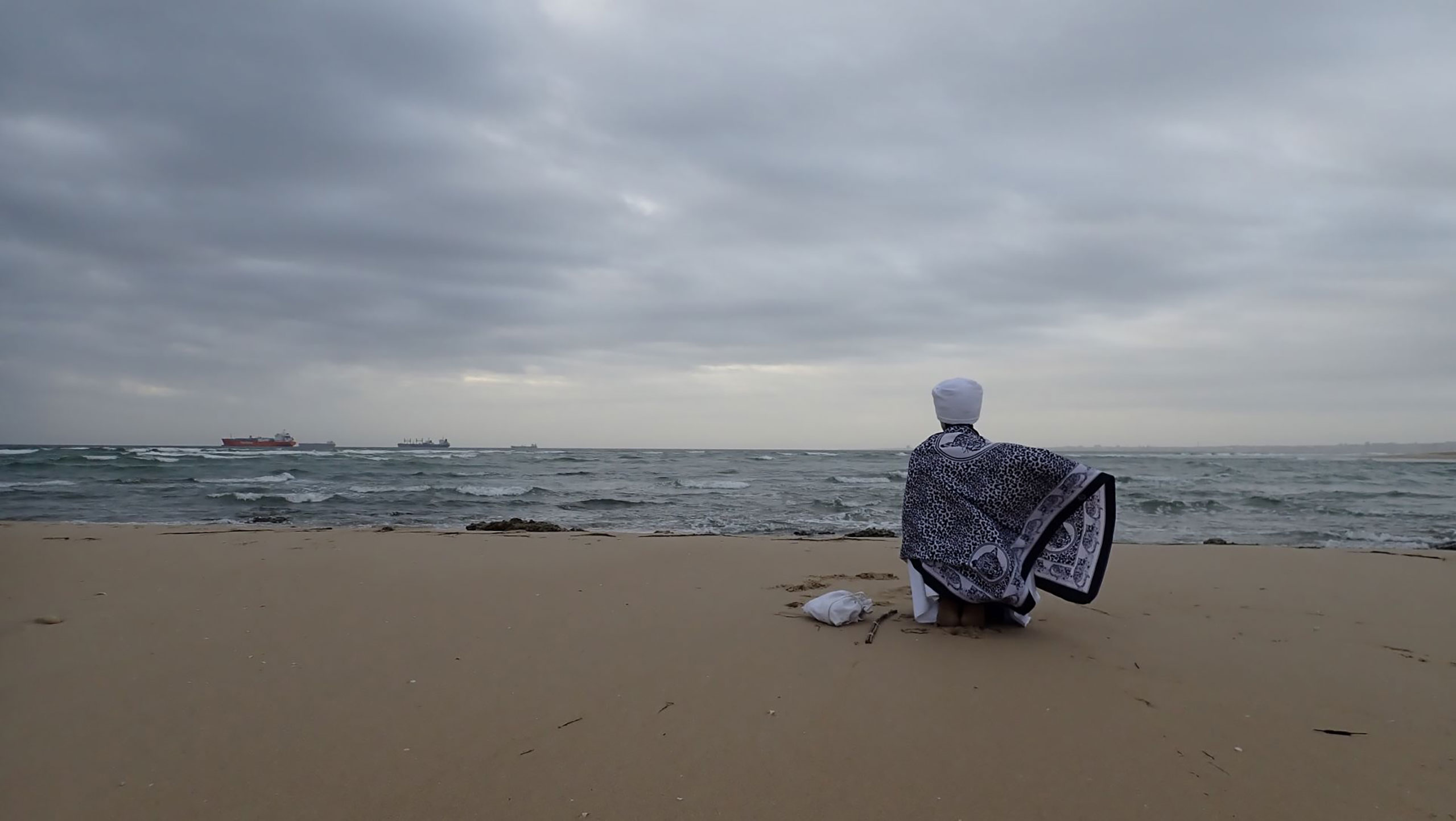
Figure 5 Siyasanga Ntabeni, a sangoma (traditional healer), on a beach in Algoa Bay. The coastline of Algoa Bay is a place where Nguni traditional healers, Sangomas, come to connect and communicate with the ancestors.
“We respect the sea a lot because we believe it is where our ancestors lived and continue to live. This is our place of serenity and (…) When we encounter life’s challenges the sea is our place of prayer. The sea is a place to regain strength when we have fallen short due to life’s tribulations. We come here to seek help and guidance as we plead with our ancestral lineage” (Siyasanga Ntabeni, 2021).
“I love sitting on the rocks and watching the waves of the sea and its beautiful colour because I get relieved when I feel heavy. But before I sit on the rocks, I have to throw a coin into the water to connect to my ancestors and seek guidance. Then they sometimes appear in our dreams to guide us about the rituals we need to do so that there can be brightness in our future” (Anelisa Mcoli, 2021).
For many Indigenous and Nguni communities in the Eastern Cape, you are closer to God and the ancestors when you are near bodies of water such as the ocean, lakes or rivers (Bernard, 2010) and people often pray near these sites (see Figure 6). The ocean is believed to have healing powers, both physically and mentally, and it is known as a place to restore health and wellness for co-researchers independent of religion, tradition and cultural heritage (see Figure 7).
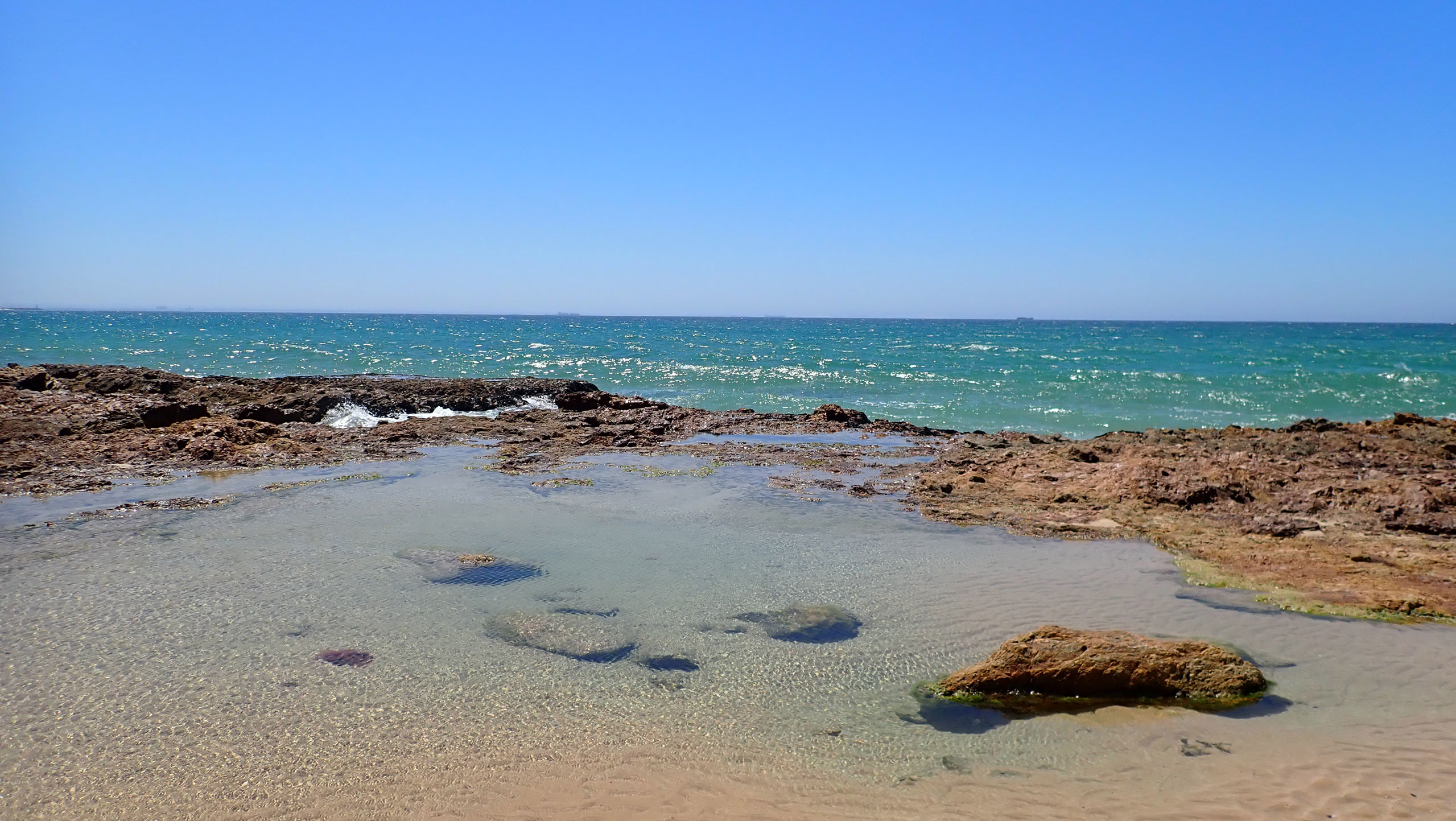
Figure 6 Photograph by Anelisa Mcoli. People often come to the ocean to connect with their ancestors and seek guidance.
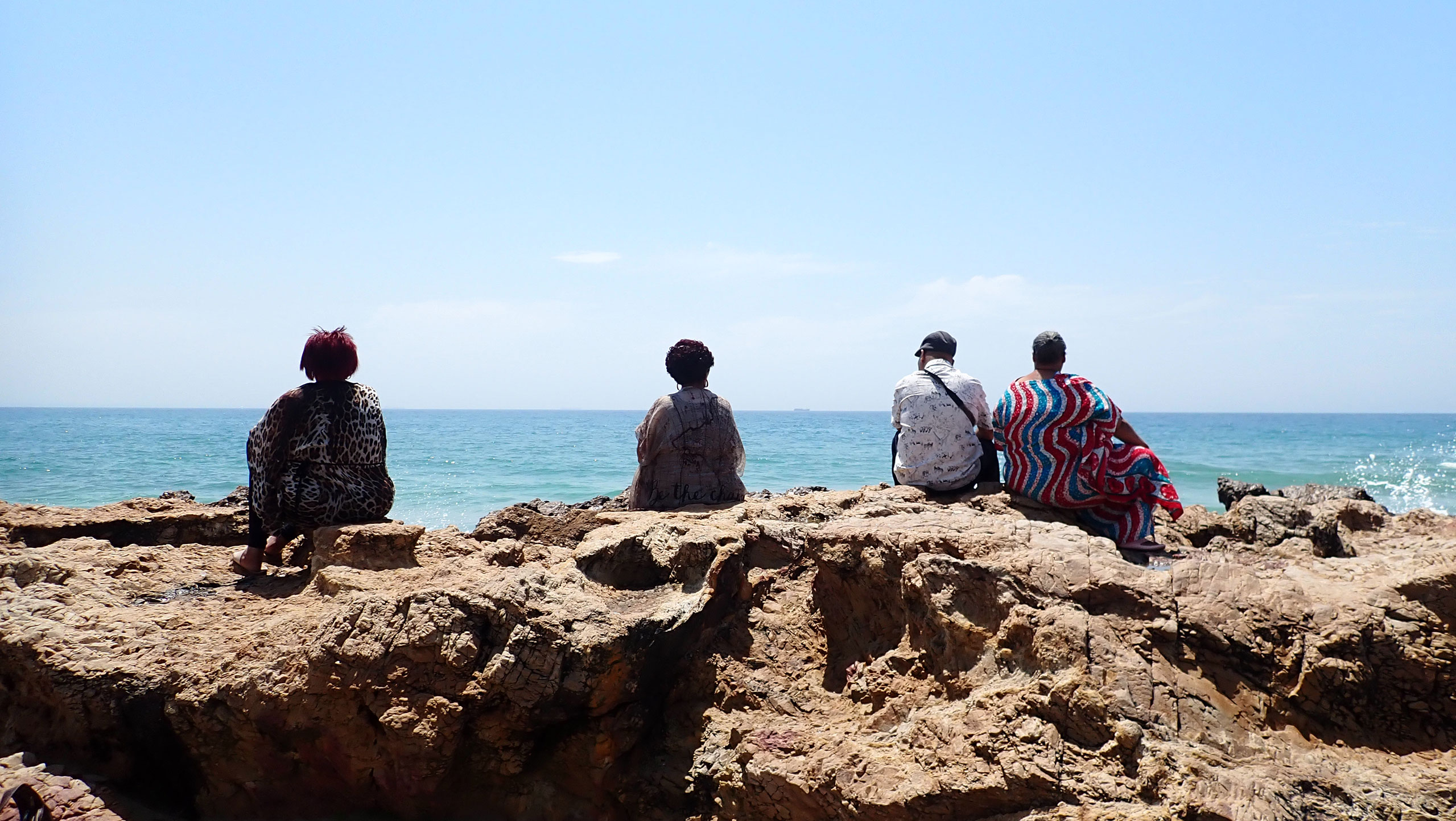
Figure 7 Eileen Speelman, Haseline van Vught, Toetie Dow and Charlotte Bouah sitting on rocks at Hobie beach. Indigenous Khoisan people often come to the ocean to pray and to connect to their ancestors.
“The sea is a place where the Khoi and San, both men and women, lived. We would fetch our food from the ocean, dig holes in the beach and build fires there to cook our food that we gathered from the ocean. This is also a place where spiritual and bodily healing comes from. If you are one with nature, this is when you are the closest to God’s creation and miracles” (Haseline van Vught, 2021).
For many residents in Algoa Bay, the ocean is a place for learning and exploring, and several co-researchers highlight wishes to further explore the ocean and coast in the future. Indigenous and local knowledge of the ocean emphasises how much we all can learn from the ocean, which further highlights the importance of taking care of the ocean and treating it with respect. This means changing the ways in which we are currently polluting and exploiting the ocean, with little consideration for the ocean and ocean life as part of us, and even less so for the generations to come (see Figure 8).
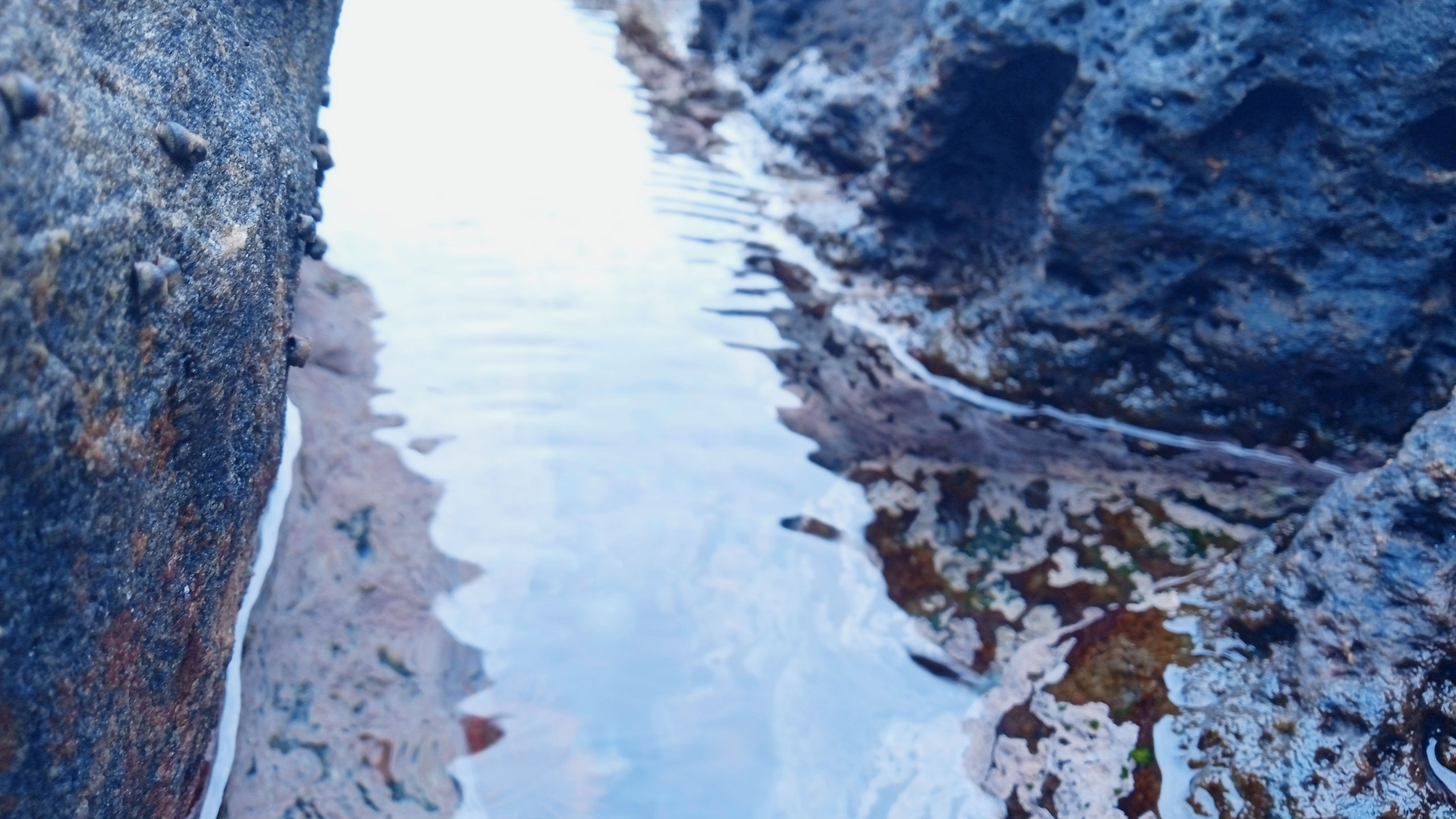
Figure 8 Photograph by future microbiologist Yaseen Albany at Schoenmakerskop, Gqeberha, highlighting the beauty of the ocean and that we need the ocean and the ocean needs us.
“I wouldn’t want to see a future where our children’s children or our children won’t be able to experience the ocean like we have. If we continue the way we are going, we will pollute the ocean, we will pollute the land around the ocean. And that will destroy it” (Yaseen Albany, 2021).
Finally, the ocean and coast is recognised by all co-researchers as a place for fun, family time, enjoyment and a place in which people find a sense of calm and peace. The co-researchers in Algoa Bay, whether they are Indigenous leaders, subsistence fishers, ocean educators, learners or swimmers, all find solitude and tranquillity in being near the ocean. Spending time near the ocean and coast therefore becomes necessary for wellbeing and mental health (see Figure 9).
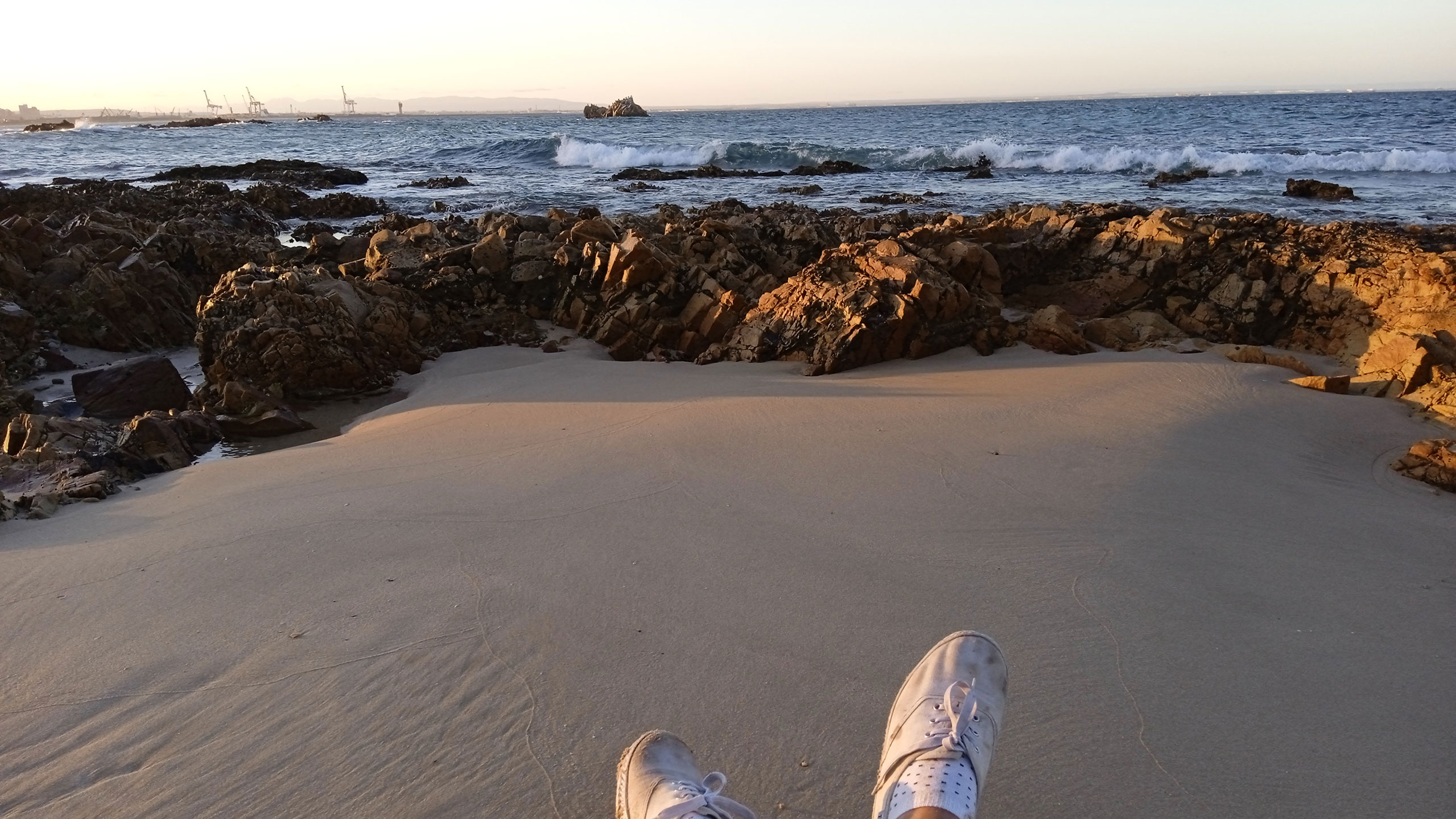
Figure 9 Photograph by Tarryn Swartbooi at Summerstrand, Gqeberha, emphasising the sense of calm she feels when she is near the ocean.
“I love this place as you completely lose the sense of time. The only way you know that time has passed is because the waves come closer and closer to your feet. And it feels so safe, you feel safe” (Tarryn Swartbooi, 2021).
Although this paper recognises the limitation of categorisation and characterisation of often very varied and differing experiences with the ocean and coast, the above spiritual, emotional, historical, experiential, relational and physical connections are sometimes grouped together and referred to as cultural connections in the remainder of this paper, arguing for the importance of their acknowledgement in future ocean stewardship and inform future ocean management.
The photographs and stories provided by the co-researchers highlight Indigenous and local knowledge that goes beyond the solely economic, biophysical and social relations to the ocean and emphasise the interdependence and co-existence of humans and the ocean (see Figure 10).
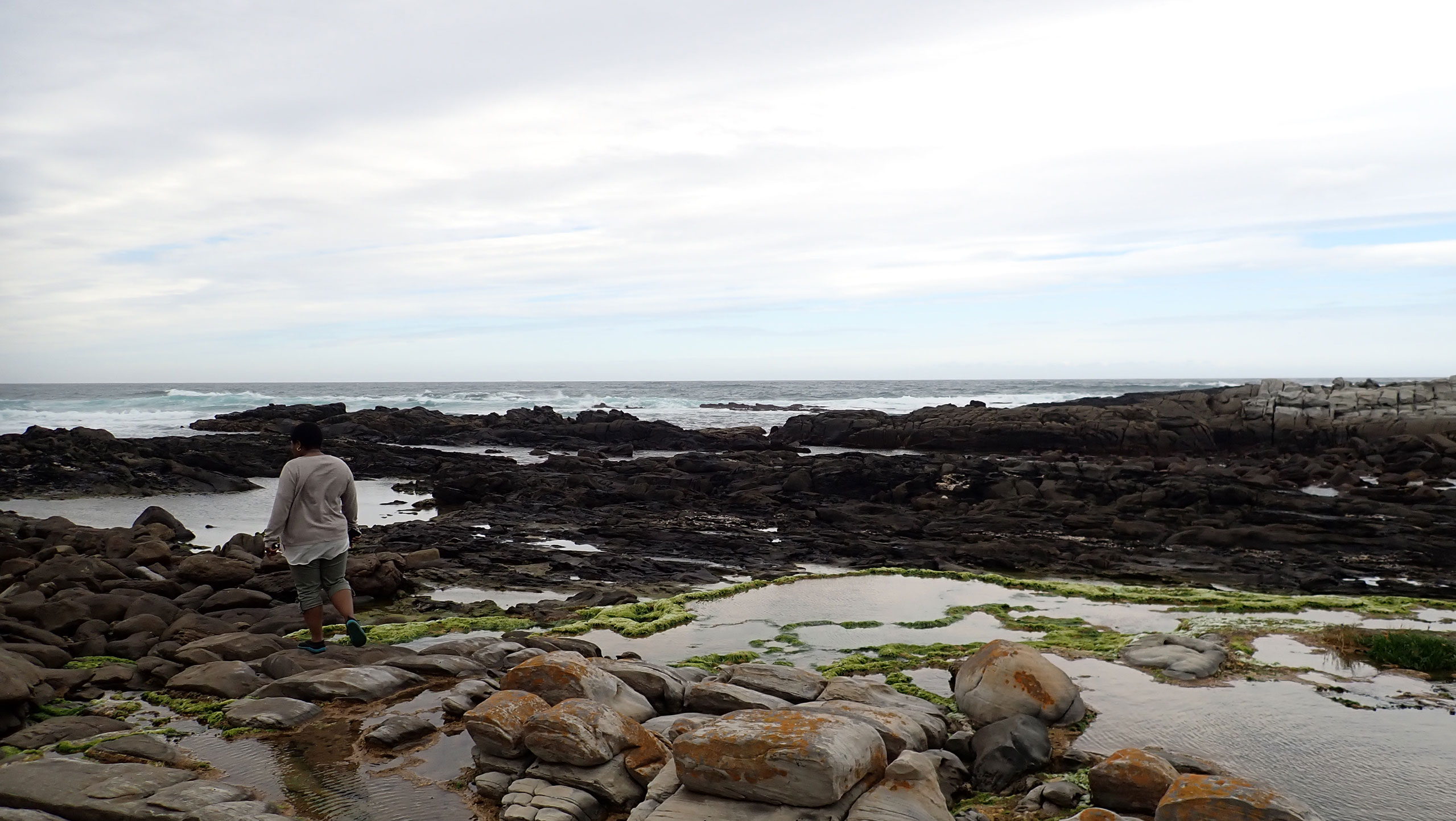
Figure 10 Nozipiwo Hambaze walking along the stromatolites on the coast near Schoenmakerskop, Gqeberha.
“I think the ocean needs to be protected in so many ways. It needs to be protected from pollution, and we need to take action and stand against the injustices done to the ocean because without the ocean, there’s no life (…) Our life depends on the ocean. Actually, life on Earth depends on the ocean, so it is very important that we keep the ocean safe, and we protect the oceans for the generations to come” (Marine and coastal educator Nozipiwo Hambaze, 2021).
The photographs and stories, highlighting Indigenous and local knowledge of the ocean and coast, demonstrate the clear interdependence on the ocean by the co-researchers. This is not just directly from marine gifts, but also from knowing that they originally came from the ocean, how the ocean is home to their ancestors in Nguni traditions, or where the ancestors used to co-exist with nature in Khoisan histories, how it represents a place where they are closer to God, that the ocean has healing powers, both physically and mentally, and that they depend on the ocean for their wellbeing in so many ways. These are the ways in which Indigenous and local co-researchers in Algoa Bay already have a sense of stewardship of the ocean. Emphasising the importance of this interdependence and encouraging people to spend more time by the ocean has the potential to increase a sense of awareness and care, or stewardship for the ocean and coast.
During the sense-making workshops the co-researchers discussed and imagined ways in which ocean and coastal management could better highlight this importance. Some suggestions that emerged were the establishment of a World Heritage Site that acknowledges and protects the ancient fish traps near Cape Recife. Other suggestions included ensuring areas of cultural significance, such as parts of the Addo Elephant National Park MPA, the Swartkops River, Cape Recife, and Sardinia Bay MPA are co-managed by Indigenous and local community representatives. Co-researchers also suggested adding a cultural layer to the MSP process in South Africa which delineates specific cultural zones for people to access sites for cultural reasons and have a stronger say in the stewardship of these areas, whether this is for spiritual, cultural, recreational and emotional reasons.
4.3 Arts-Based Participatory Research Useful in (Re)imagining Better Futures for the Ocean and Coast
In this study, that explores ways in which Indigenous and local knowledge holders relate to the ocean and the coast in Algoa Bay, ABPR has proven particularly useful in conveying dynamic and ever-changing aspects of culture (Kirshenblatt-Gimblett, 2004), such as people’s sense of belonging, heritage, spiritual connections and sense of identity. These cultural dimensions should inform current ocean management approaches as they can contribute towards creative and innovative responses to ‘transformations in social-ecological systems’ (Galafassi et al., 2018). At a time when the ocean is facing complex social-ecological challenges and wicked problems (Benham and Daniell, 2016), coastal communities and their ocean knowledge can and should contribute to these innovative solutions (see Figure 11).
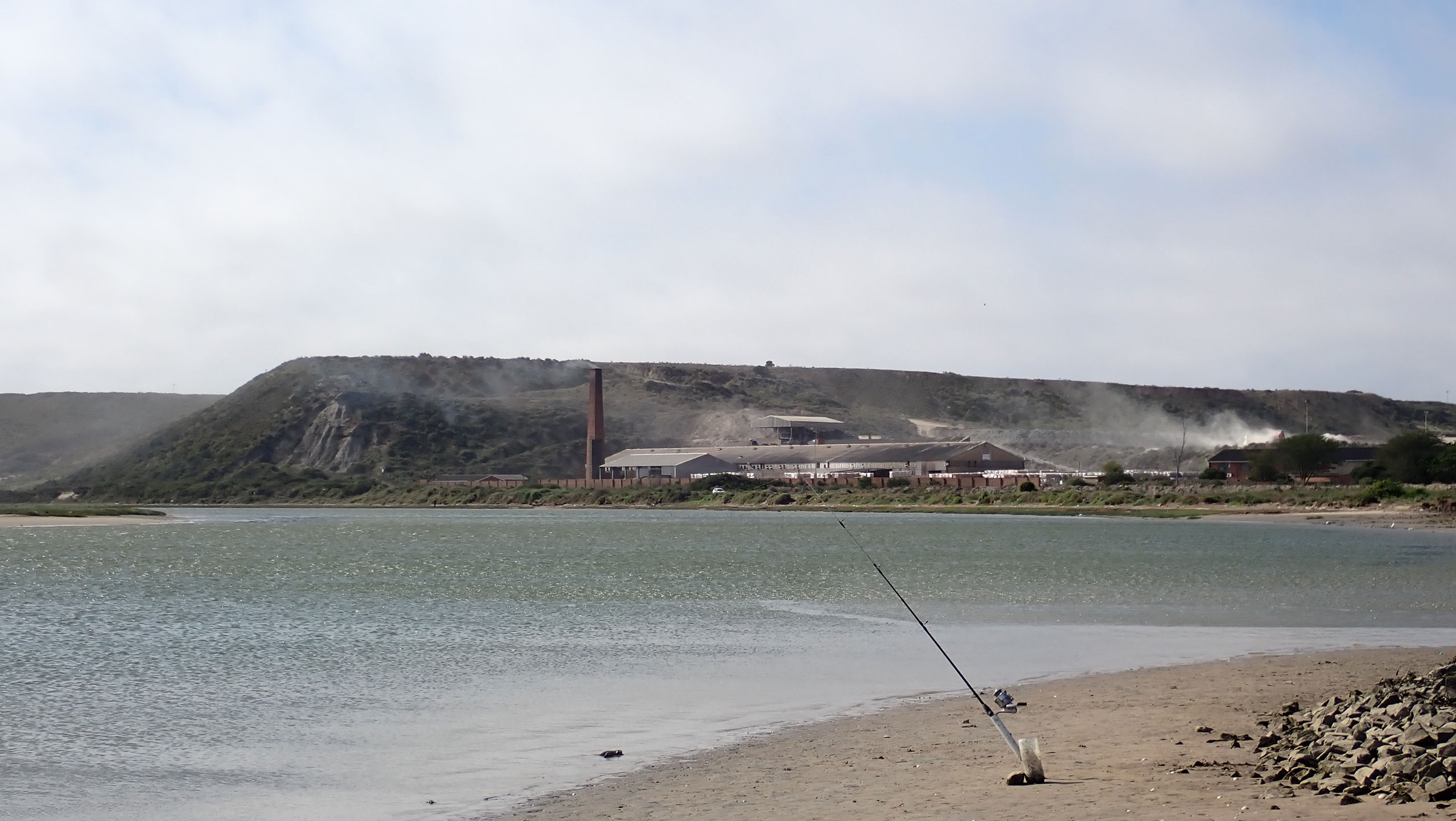
Figure 11 Factories on the banks of the Swartkops River, near Aloes Community, contribute to industrial waste into the river where resident Francis Nkaki fishes and collects bait.
The particular arts-based process used was helpful in identifying themes of cultural, spiritual and traditional connections to the ocean and coast that should inform future ocean management. It allowed for remembering the past and imagining better futures where Indigenous and local communities had or have a stronger say in the stewardship of their coast and ocean. Piloting ABPR with co-researchers in Algoa Bay thus finds that these methods can be useful in remembering and imagining, or reimagining, ways in which people relate to and care for the ocean and coast.
“We who live off the fish feel the effects of ocean pollution and the changing climate the most. We have been living here for generations and have seen the changes ourselves” (Subsistence fisher and bait collector Francis Nkaki, 2021).
The combination of photography and storytelling, known as photovoice, has been useful in remembering the past. Whether this is through personal memories or stories handed down through famililies or community members, the value of remembering cannot be overstated in the context of post-apartheid South Africa and Algoa Bay. In the Bay, Indigenous Khoisan and Nguni communities settled thousands of years ago, and the dependence on the ocean for livelihoods, subsistence, spirituality, health, recreation and ceremonies dates back to at least 8,000 years (Barnard, 1992). The usefulness of in situ photography relates to the act of ‘going back’, activating the process of remembering, visiting places of memories and histories, and sometimes reliving these memories (see Figure 12).
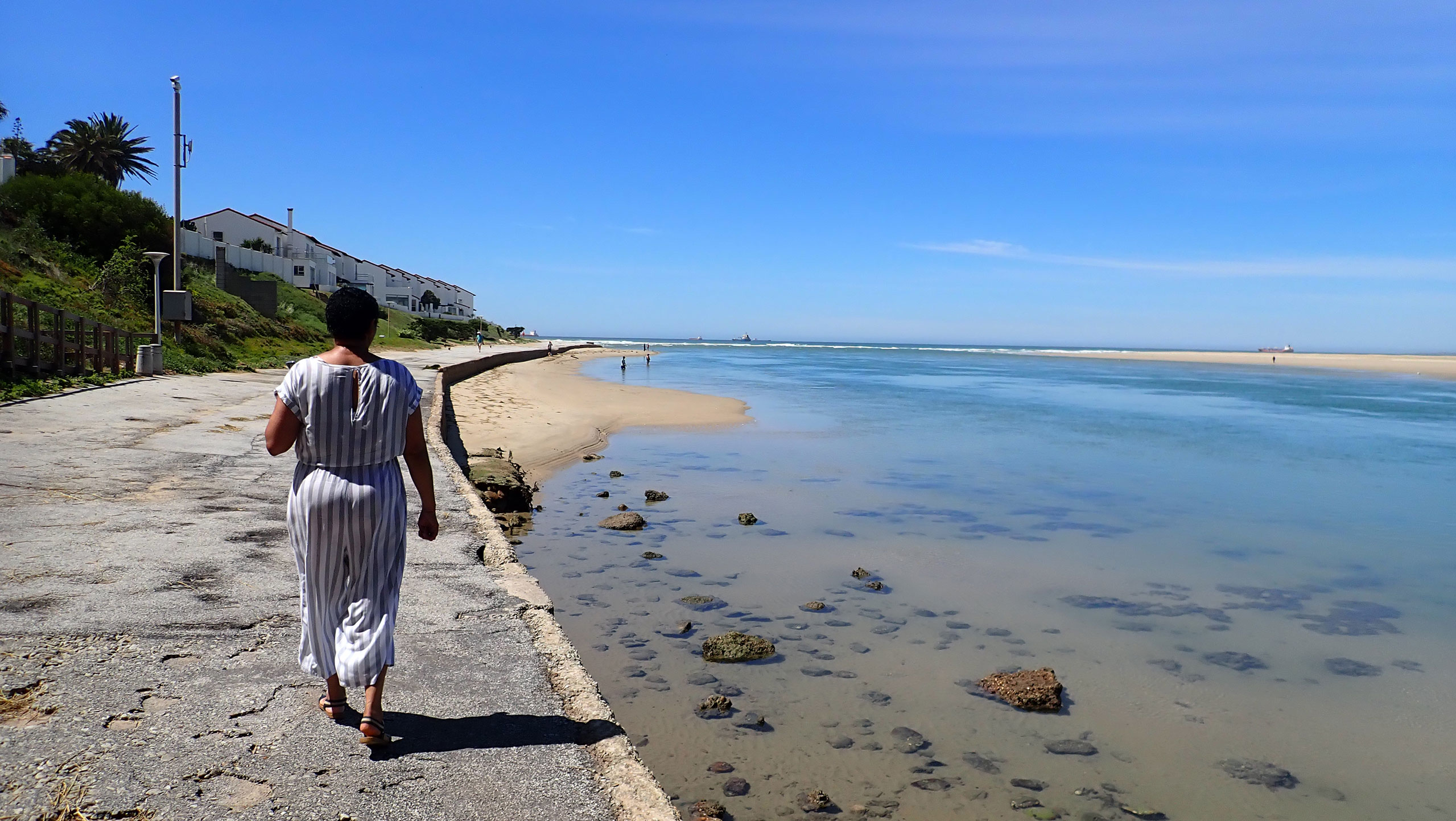
Figure 12 Delene Spandiel walking along Bluewater Bay, where she used to come with her family when she was younger.
“This is where it all started (…). We would come and camp and fish here on the banks. I have a real connection to the ocean. My father and forefathers were fishers. We are now involved with the small-scale fishing cooperative. It was something that we had to do. We did struggle in the past, but everything is falling into place” (Delene Spandiel, 2021).
ABPR is also useful in imagining alternative present and future scenarios. Current biodiversity research often fails to mobilise transformative change despite its scientific framing of ‘future trajectories of decline’ and creative approaches that encourage imagination are necessary to ‘foster new ways to address long standing problems to create better futures for people and the planet’ (Wyborn et al., 2020). In the context of Algoa Bay, several places have historically been closed off for residents due to apartheid regulations or is currently closed off for economic development or biodiversity preservation (see Figure 13). Co-researchers visited these places and expressed what these places meant to them, whether it be in the past, present or future. These conversations allowed for the development and creation of stories and narratives where there are no economic barriers, where transportation access is lessened, where people might even be able to move back to neighbouring areas, where people are again allowed to fish, harvest, perform rituals or camp, where people with invested interests in the wellbeing of the natural environment and biodiversity of an area are members of management committees, or even fully manage these areas themselves.
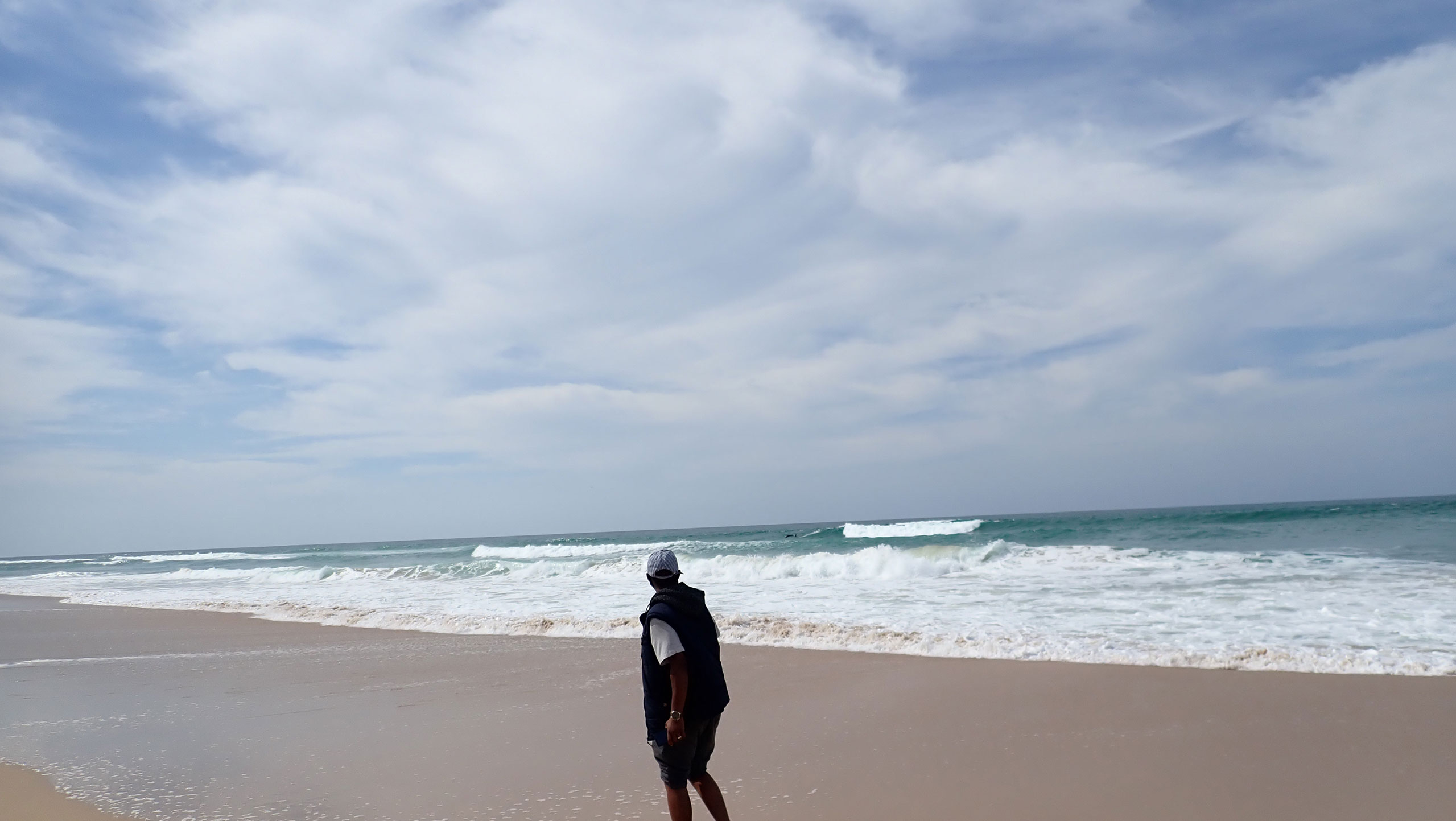
Figure 13 Bradley Links walking along the beach near the Sundays Estuary, with dolphins playing in the waves in the background. People have to pay to access this estuary and beach.
“Everybody should have access to the ocean. The way you feel being near the ocean is so amazing, the feeling is indescribable. You feel at peace, you feel phenomenal, and nature can often help you find a purpose. I want more people from my community to have that feeling. By having access to this coast it could help more people in my community find a purpose or find themselves” (Resident of Colchester community Bradley Links, 2021).
Furthermore, several co-researchers emphasised the importance of increased access and sharing of information with the younger generations, as the ways in which we manage the oceans and coast today will impact them the most in the future (see Figure 14). Specific imaginings therefore included free access for children with an accompanying adult to all places along the coast in Algoa Bay and for schools to bring children to the ocean to teach them more about the ocean and ocean life. Generally, co-researchers emphasised the importance of increasing education focus on the ocean, as well as on how Indigenous people of South Africa used to live along the coast and co-exist with the ocean and the gifts it provides.
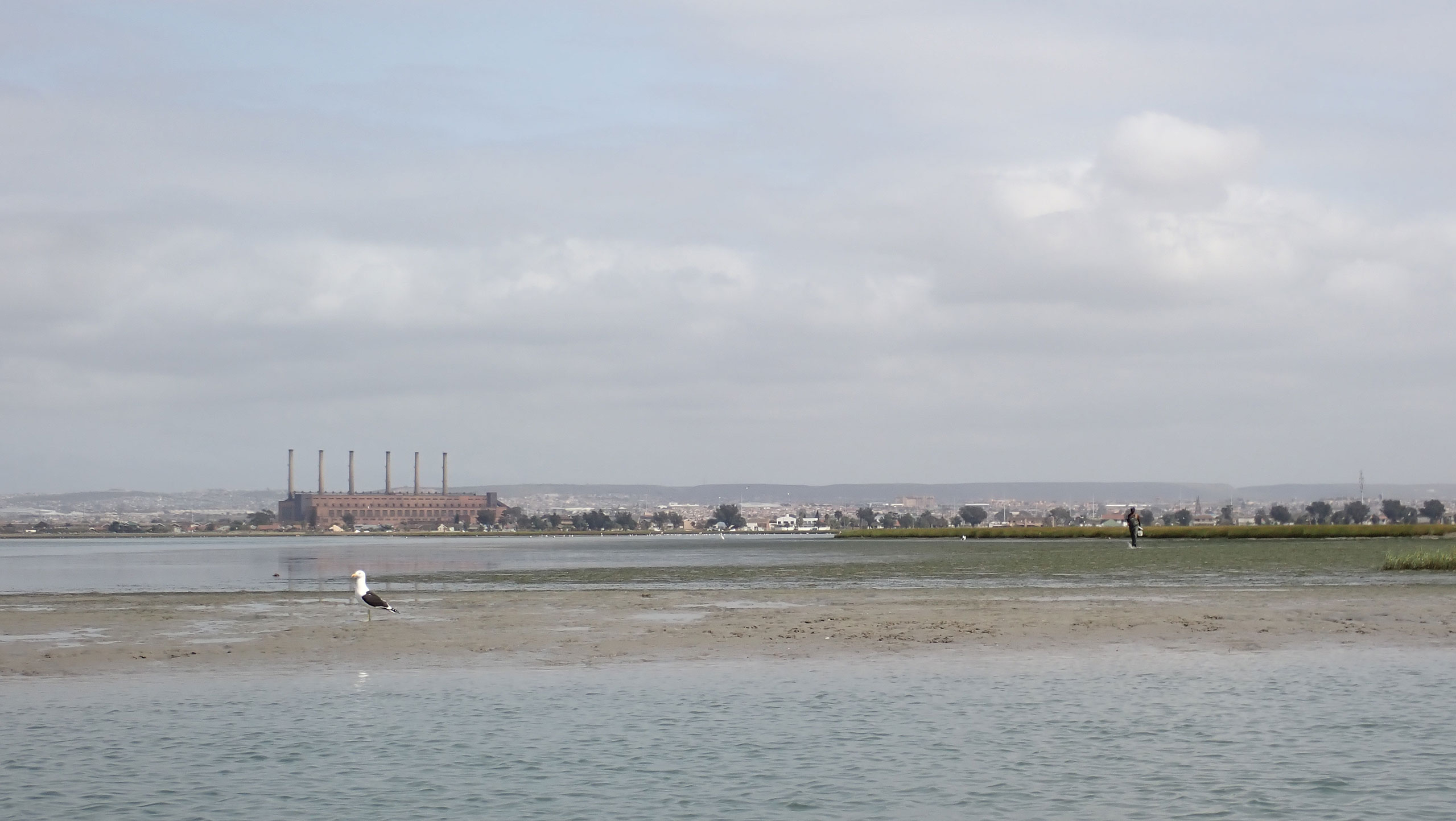
Figure 14 The Swartkops estuary, where Jenny Rump works with the Zwartkops Conservancy to promote public awareness on caring for the river ecosystem.
“It is hard, but we try our best in educating the next generation to take care of the environment and know that it is not just for the aesthetic, it is for our survival” (Jenny Rump, 2021).
In a world, or Bay, where the management of our oceans seem so disconnected with people’s sense of connection with the ocean beyond economic gains or biodiversity preservation (see Lombard et al., 2019),8 the importance of encouraging the imagination to remember and imagine different realities cannot be overstated. Asking someone about their connection to a specific place, how they feel in a particular area, and what a location might mean to them without any word limit, timeframe or format, allows stories of senses, feelings, emotions and belonging. Another emerging result is that the more people feel connected to a place or an area, the more they want to be involved in managing and preserving it.
“To better preserve ocean life we need more education around it and give it in the hands of the cultural leaders, the fishing community or the cultural community. They will look better after it and they will preserve it and not exploit it" (Eastern Cape Khoisan Small-Scale Fishing Cooperative Chairman Deon Spandiel, 2021)”
Co-imagining solutions to better ‘hear’ and ‘see’ Indigenous and local knowledge in ocean decision-making identified potential approaches such as establishing an Indigenous and local knowledge committee to sit on the National Maritime Spatial Planning Working Group (DFFE, 2021), invite Indigenous and local residents in provincial, district and municipal meetings regarding the management of the ocean and coast, broadening the recognition of marine cultural heritage in the planning and implementation of management plans according to the legal framework as outlined by NHRA, ensuring that Indigenous and local community representatives take part in the mapping of the future marine area plans and recognising cultural uses and connections of the ocean and coast alongside economic, environmental and social priorities.
5 Discussion
To reimagine alternatives to top-down natural resource management, we need alternatives to knowledge production for sustainable resource management and governance that perpetuate asymmetric power relations. Current knowledge systems and science that currently underpins area-based ocean management needs to be questioned and whether these are contextually relevant. Furthermore, this section argues for the importance of a social-ecological systems (SES) approach to both knowledge production and ocean governance and argues for including the concept of ‘cultural sustainability’ alongside the social, environmental and economic. We argue that we should rethink our approach to marine resource stewardship in Algoa Bay and South Africa more broadly, to learn from ILKS in how we can better co-exist with our environment and challenge current top-down strategies which continue to exclude and marginalise those who depend on healthy oceans and coasts the most.
5.1 Knowledge Co-Creation to Inform Ocean Management Policy
One of the main findings from working closely with co-researchers across the Bay is that there are currently limited options for people to contribute to knowledge co-creation for ocean and coastal management and even to have their say about proposed management approaches and policies. An example includes the national MSP development and implementation process, which has, to date, mainly relied on virtual information sessions, leading to exclusion of stakeholders that lack access to online platforms. The establishment of MPAs in South Africa is also problematic as engagement is often of a consultative instead of collaborative nature, informing stakeholders of already established plans. Several studies on integrated ocean management approaches such as MSP and MPAs highlight the importance of ‘early and often’ stakeholder engagement for successful ocean management (Rivers et al., 2022), but the mandatory stakeholder engagement exercises are not prescriptive enough and often end up being mere tickbox exercises for management authorities.
As has been argued extensively elsewhere (Sloan, 2009; Gopnik et al., 2012; Rivers et al., 2022), the limited scope and reach of stakeholder engagement processes point to the fact that we should rather focus on stakeholder collaboration. To make sure we are working towards marine resource management and MSP that really acknowledges the interests of the people that depend on these resources, inclusive knowledge co-creation needs to inform policy-making at its initial stages and therefore inform the legal framework and finally, implementation. Co-creation of knowledge regarding the sociocultural connections, values and priorities of the coast and ocean with Indigenous and local communities should be organised before the implementation of integrated ocean management approaches and as part of adaptive management processes. Ideally, to avoid knowledge extraction, devaluation and depreciation (see Latulippe and Klenk, 2020), this should translate into meaningful representation on decision-making bodies and management councils that propose and execute policies and decisions.
5.2 Arts-Based Methods to Highlight Local Ocean Stewardship
One emerging alternative to top-down knowledge production is knowledge co-creation through ABPR. This study finds that ABPR proves significantly useful in conveying cultural connections and relationships to the ocean and coast that are often neglected, silenced or omitted in ocean management approaches. Although truly participatory and collaborative, knowledge co-creation processes take time and investment to build trust and relationships, resources to ensure equitable participation in workshops and field visits, and flexibility to accommodate co-researchers’ time, life and schedules. This dedication and commitment are necessary to ensure ocean management is inclusive and contextually representative. These ‘challenges’ will always remain a reality when aiming to facilitate truly collaborative processes.
Ocean stewardship, or people’s sense of responsibility and care for the ocean and the ways in which they interact with the coast and ocean, is not something that always needs to be taught or reinvented. When engaging with Indigenous and local community representatives in Algoa Bay, we find that ocean stewardship already exists through people’s cultural connections with the ocean and coast. The ABPR approach makes this knowledge explicit so it can be increasingly ‘heard’ and ‘seen’ in ocean management and therefore allows a reimagining of what ocean stewardship has meant in the past and can mean in the future.
Knowledge co-creation faces several challenges, however, such as the danger of knowledge extraction, knowledge depreciation, and the misconception of knowledge as ‘global rather than tied to a place or a way of life’ (Latulippe and Klenk, 2020). By treating knowledge as something that can be separated from its origins, and as ‘data that can be aggregated and understood in abstract and universal form’ (Latulippe and Klenk, 2020), knowledge co-creation processes can become transactional and extractive despite the best of intentions. This highlights the importance of place-based knowledge and contextually relevant responses, which are often in conflict with international efforts of sustainability research and national efforts at integrated ocean management approaches such as South African MSP only aiming to develop four different marine area plans (DFFE, 2021). Making sure Indigenous and local knowledge is properly ‘seen’ and ‘heard’ could at least improve the contextuality of these plans and support ocean stewardship in local contexts.
5.3 Conceptualising Place-Based ‘Cultural Sustainability’ for Ocean Governance
Cultural connections and values attached to ocean and coastal spaces are often neglected and overlooked in area-based ocean management approaches (see Gee et al., 2017; Saunders et al., 2020; Gilek et al., 2021). This is sometimes argued to be due to challenges of recording and conceptualising the intangible nature of these connections (Gee et al., 2017), which highlights the value of arts-based methods and alternative ways of conveying knowledge beyond the written word. Furthermore, because cultural values often generate a sense of identity and place and are often related to quality of life and well-being, Gee et al. (2017:140) highlight how the neglect of cultural aspects of people’s dependency on the ocean and coast can diminish people’s choices and lead to ‘irrevocable loss of key marine benefits’. As we have seen above, the ocean and coast play a vital role in defining local, regional and national cultures and signify places of heritage, ancestry, imagination and projection (also see Gee et al., 2017; DFFE, 2021).
Scrutinising current ocean management strategies in South Africa, this study finds that the cultural connections, as highlighted by co-researchers, are not adequately recognised. For example, a recent review of current MPA management in South Africa concludes that more than 50% of all MPAs currently have ‘seriously constrained’ or ‘no management’ of cultural heritage knowledge within the MPAs (Adams and Kowalski, 2021). Specifically in the Sardinia Bay MPA, in the West of Algoa Bay, cultural heritage is identified as ‘priority indicators for management effectiveness’ due to limited information about cultural heritage ‘assets. According to Adams and Kowalski (2021) this is in part due to the fact that both cultural heritage and biodiversity knowledge are ‘not in a format that is accessible and understandable to the MPA manager for decision making’. There is also a limited definition and understanding of what constitutes cultural heritage, as the report primarily focuses on shipwrecks and whaling stations (besides fish traps, guano, historical fishing sites, and seal harvesting sites, which are all mentioned once or twice). Cultural heritage sites should be managed using the Indigenous Knowledge Act of 2019 and the NHRA of 1999, which clearly recognises living heritage such as oral history, cultural tradition, rituals and Indigenous knowledge systems as well as the cultural significance of social and spiritual values (Republic of South Africa, 1999).
Although the South African Department of Forestry, Fisheries and the Environment (DFFE)’s MSP working group recognises the importance and relevance of ‘intangible values of the marine and coastal environment’ and states that the ocean forms part of ‘cultural, spiritual and aesthetic wealth’, shipwrecks are again the primary focus of marine cultural heritage (DFFE, 2021). Maritime cultural heritage is exclusively managed at a national level and although the country has a ‘firm legal and policy framework for the management and protection of maritime and underwater cultural heritage resources’, the ‘implementation of this framework is lacking due to capacity constraints’ (DFFE, 2021).
According to Gee et al. (2017), the reason for the neglect of cultural values in ocean management, and MSP more specifically, is their resistance to spatial delineation, awareness gaps about cultural benefits, and conceptual challenges related to the intangible nature of some cultural connections. Intangible heritage, as opposed to tangible heritage, is not necessarily linked to something concrete or static, whether it is an object, a place or a song. Intangible cultural heritage is often alive and ever-changing, linked to oral traditions, a system or dynamic spatio-temporal conditions (Kirshenblatt-Gimblett, 2004). The challenge therefore lies in sustaining and representing this system ‘as a living entity’, which is difficult to capture by the written word or a static map (Kirshenblatt-Gimblett, 2004). Another challenge is the different conceptualisations of culture and how some might resist classification and even articulation. An example is sacred heritage and places that are too sensitive to mention or mark on maps. As we have established earlier in this paper, there also seems to be a resistance in even discussing the cultural underpinnings of current area-based ocean management approaches and recognising that cultural values are at the core of defining priorities for ocean management, both at international and national scales.
By failing to acknowledge and understand cultural interactions with the environment and the cultural dimensions of ecosystem challenges, ocean governance strategies hinder collaborative management and instead reproduce social inequalities. As highlighted by DFFE (2021), the ways in which the ocean and coast forms part of people’s aesthetic, cultural and spiritual wealth is a ‘crucial source of socio-economic development and human well-being’.
5.4 The Relevance of Indigenous and Local Knowledge in Ocean Stewardship
We need local responses to local problems, where the knowledge and science that inform policies is built on and informed by local and Indigenous knowledge and representation (Nhemachena et al., 2016; Chilisa, 2019). By asking people what they would do if they could influence the management of an area, you encourage local priorities to envision or inform possible solutions or action. There is a need to challenge current top-down ocean management strategies which continue to exclude and marginalise people who depend on a healthy environment the most and fail to recognise cultural connections and relationships to the ocean and coast.
Exploring people’s relationship to the ocean and coast in Algoa Bay highlights that although these relationships are sometimes devalued or omitted from current ocean management approaches, this does not have to be the case. A majority of co-researchers agree with conservation measures but want to be further involved in these processes and have a say in how the areas are being managed. Suggestions by co-researchers include involving community members on management committees, improving the management of marine cultural heritage by adhering to the broad definition stipulated by the NHRA when it comes to both intangible and tangible heritage, and opportunities to establish world heritage sites as recognised by South African law (see DFFE, 2021). However, these suggestions will not necessarily translate into more inclusive ocean management because structures and mechanisms for collaboration and meaningful collaboration have to be put into place, as well as capacity built in for this. As a start, Indigenous and local knowledge holders should be offered meaningful representation on high-level decision-making bodies and management councils that propose and execute policies and decisions.
Vierros et al. (2020) argue that Indigenous and local knowledge systems can ‘provide valuable lessons on how to improve governance and management of the global ocean commons’, whilst Mulalap et al. (2020) highlight how traditional ecological knowledge in the Pacific region recognises the connectivity of social-ecological systems and species and provides best practice for environmental management through co-existence approaches that recognises communities’ interdependence to the ocean. In the context of Algoa Bay, co-researchers’ sense of identity and heritage tied to the ocean and coast strengthen their sense of ocean stewardship and desire to be involved in ocean management processes. As many environmental challenges facing our ocean are anthropogenic, an increased sense of stewardship by people can contribute towards increased ocean and coastal sustainability. ‘Hearing’ and ‘seeing’ ILKS in ocean management can therefore increase people’s sense of stewardship, not only contributing to more inclusive decision-making but also recognising existing ocean stewards and valuing them to further impact sustainable management of our oceans and coasts.
6 Conclusion
Following the above findings and discussion, this paper concludes that we urgently require co-produced knowledge with Indigenous and local communities as co-researchers to improve the ways we steward our oceans and coasts in an inclusive and equitable manner, which increases buy-in of communities, helps coastal managers and works towards developing shared visions of protection and benefit-sharing. Arts-based approaches to knowledge creation have the opportunity to bring together different ways of knowing, support creative thinking, and encourage the reimagining of what stewardship of natural resources and ocean management can and should look like, which is necessary for sustainable and equitable ocean and coastal futures. In Algoa Bay, which is the pilot site for the South African MSP development process, Indigenous and local knowledge holders’ sense of ocean stewardship is closely linked to their cultural connections to the ocean and coast, and further research should therefore investigate how ocean management processes can better ‘hear’ and ‘see’ these connections in the future.
Data Availability Statement
The original contributions presented in the study are included in the article/supplementary materials. Further inquiries can be directed to the corresponding author.
Ethics Statement
The studies involving human participants were reviewed and approved by Research Ethics Committee (Human), Nelson Mandela University. Written and verbal informed consent to participate in this study and contribute to this article was provided by the co-researchers or by the participants’ legal guardian/next of kin.
Author Contributions
This article was conceptualised by MS with the supervision of NR and BS. Research was conducted by MS with the supervision of NR and BS. MS led the development of the final output with significant contributions from both NR and BS. All authors contributed to the article and approved the submitted version.
Funding
This work was supported by the National Research Foundation (NRF) of South Africa [grant number: 129498]; the NRF through the South African Research Chair Initiative in Marine Spatial Planning and the Institute for Coastal and Marine Research at Nelson Mandela University, Gqeberha, South Africa [grant number: 110612]; South Africa - Norway Research Co-operation on Blue Economy, Climate Change, the Environment and Sustainable Energy 2018-2023 [project number:13591000]; and the One Ocean Hub [grant number: NE/S008950/1].
Conflict of Interest
The authors declare that the research was conducted in the absence of any commercial or financial relationships that could be construed as a potential conflict of interest.
Publisher’s Note
All claims expressed in this article are solely those of the authors and do not necessarily represent those of their affiliated organizations, or those of the publisher, the editors and the reviewers. Any product that may be evaluated in this article, or claim that may be made by its manufacturer, is not guaranteed or endorsed by the publisher.
Acknowledgments
This paper would not be possible without the incredible collaboration with all the co-researchers and their invaluable insights into Indigenous and local knowledge of the Algoa Bay coast and ocean. The paper also acknowledges the invaluable contributions of our very own art historian, photojournalist, audio story expert, translators, partners and colleagues.
Footnotes
- ^ None of the people on Reuters’ 2021 ‘Hot List’ of 1000 influential scholars in climate change are women from African institutions, and only four are from institutions on the African continent, which are solely men from South Africa (Schipper et al., 2021).
- ^ See Maritime Zones Act, 1994.
- ^ Knowledge co-creation is closely linked to the concept of social learning which also brings various stakeholders or knowledge holders together to work on complex social-ecological problems (Wals, 2007; Cundill and Rodela, 2012; Rodela et al., 2012)
- ^ This study deliberately works with people as co-researchers, ensuring that ‘participants’ have opportunities to be involved in every step of the research process from defining objectives to analysing results (see Strand et al., 2022, forthcoming).
- ^ While the definition of social learning is contested, a broad definition of the concept is ‘the bringing together of multiple perspectives, values and interests in order to creatively work on stubborn practices that lead to unsustainability’ (Rivers, 2015). Wals (2007) also argues that social learning is not so much what people should know or be able to do, but rather a process that uncovers what people want to learn, how they learn, how people overcome personal biases and group thinking, and how people can become more sensitive to alternative ways of knowing, valuing and doing. See Strand et al., 2022 (forthcoming) for an extensive discussion on the role of social learning in developing the methods for this specific study.
- ^ See Sunde and Erwin (2020) on an extended discussion and elaboration about the challenge and politics around trying to make distinctions between these two groups of fishers in a South African context.
- ^ See Kemp (2006) for an extensive analysis of stonewall fish traps on the southern coast of South Africa, and Jerardino (2012) on an outline of large shell middens on the western coast of South Africa.
- ^ Lombard et al. (2019) highlight the strong economic growth focus of the National Development Plan and Operation Phakisa in South Africa, and the ecosystem-based focus of the Marine Spatial Planning Bill of 2018.
References
Adams R. J., Kowalski P. (2021). State of Marine Protected Area Management Effectiveness in South Africa (Cape Town: World Wild Fund for Nature South Africa).
Appadurai A. (1996). Modernity at Large: Cultural Dimensions of Globalization (Minnesota: University of Minnesota Press).
Barnard A. (1992). Hunters and Herders of Southern Africa: A Comparative Ethnography of the Khoisan Peoples (Cambridge: Cambridge University Press).
Barone T., Eisner E. W. (2012). Arts Based Researc (Los Angeles: SAGE). Available at: http://dx.doi.org/10.4135/9781452230627.
Benham C. F., Daniell K. A. (2016). Putting Transdisciplinary Research Into Practice: A Participatory Approach to Understanding Change in Coastal Social-Ecological Systems. Ocean Coast. Manag. 128, 29–39. doi: 10.1016/j.ocecoaman.2016.04.005
Bennett N. J., Whitty T. S., Finkbeiner E., Pittman J., Bassett H., Gelcich S., et al (2018). Environmental Stewardship: A Conceptual Review and Analytical Framework. Environ. Manage. 61, 597–614. doi: 10.1007/s00267-017-0993-2
Berkes F. (2015). Coasts for People: Interdisciplinary Approaches to Coastal and Marine Resource Management (New York: Routledge).
Bernard P. S. (2010). Messages From the Deep: Water Divinities, Dreams and Diviners in Southern Africa (Makhanda: Rhodes University). unpublished thesis.
Capous-Desyllas M., Morgaine K. (2018). Creating Social Change Through Creativity: Anti-Oppressive Arts-Based Research Methodologies (Switzerland: Palgrave Macmillan). doi: 10.1007/978-3-319-52129-9.
Carstens W. P. (1966). The Social Structure of a Cape Coloured Reserve (Cape Town: Oxford University Press).
Castleden H., Garvin T., First Nation H. (2008). Modifying Photovoice for Community-Based Participatory Indigenous Research. Soc. Sci. Med. 66 (6), 1393–1405. doi: 10.1016/j.socscimed.2007.11.030
Chambers J. M., Wyborn C., Ryan M. E., Reid R. S., Riechers M., Serban A., et al. (2021). Six Modes of Co-Production for Sustainability. Nat. Sustain. 4, 983–996. doi: 10.1038/s41893-021-00755-x
Christie P., Bennett N. J., Gray N. J., Wilhelm T 'A., Lewis N., Parks J., et al. (2017). Why People Matter in Ocean Governance: Incorporating Human Dimensions Into Large-Scale Marine Protected Areas. Mar. Policy 84, 273–284. doi: 10.1016/j.marpol.2017.08.002
Cundill G., Rodela R. (2012). “A Search for Coherence: Social Learning in Natural Resource Management,” in (Re)Views on Social Learning Literature: A Monograph for Social Learning Researchers in Natural Resource Management and Environmental Education. Ed. Lotz-Sisitka H. B. (Makhanda, South Africa: Environmental Learning Research Centre, Rhodes University/EEASA/SADC REEP), 12–27.
DFFE (2021). National Data and Information Report for Marine Spatial Planning: Knowledge Baseline for Marine Spatial Planning in South Africa (Cape Town: South Africa: Department of Forestry, Fisheries and the Environment).
Dorrington R. A., Lombard A. T., Bornman T. G., Adams J. B., Cawthra H. C., Deyzel S. H.P., et al. (2018). Working Together for Our Oceans: A Marine Spatial Plan for Algoa Bay, South Africa. South. Afr. J. Sci. 114 (¾), 1–6. doi: 10.17159/sajs.2018/a0247
Elwell T. L., Gelcich S., Gaines S. D., Lopez-Carr D. (2018). Using People’s Perceptions of Ecosystem Services to Guide Modeling and Management Efforts. Sci. Total Environ. 637–638, 1014–1025. doi: 10.1016/j.scitotenv.2018.04.052
Flannery W., Healy N., Luna M. (2018). Exclusion and Non-Participation in Marine Spatial Planning. Mar. Policy 88 (1), 32–40. doi: 10.1016/j.marpol.2017.11.001
Foster V. (2016). Collaborative Arts-Based Research for Social Justice (New York: Routledge). doi: 10.4324/9780203077450
Gadgil M., Berkes F., Folke C. (1993). Indigenous Knowledge for Biodiversity Conservation. Ambio 22 (⅔), 151–156.
Galafassi D., Daw T. M., Thyresson M., Rosendo S., Chaigneau T., Bandeira S., et al. (2018). Stories in Social-Ecological Knowledge Cocreation. Ecol. Soc. 23 (1), 1–13. doi: 10.5751/ES-09932-230123
Gee K., Kannen A., Adlam R., Brooks C., Chapman M., Cormier R., et al. (2017). Identifying Culturally Significant Areas for Marine Spatial Planning. Ocean Coast. Manag. 136 (1), 139–147. doi: 10.1016/j.ocecoaman.2016.11.026
Gilek M., Armoskaite A., Gee K., Saunders F., Tafon R., Zaucha J. (2021). In Search of Social Sustainability in Marine Spatial Planning: A Review of Scientific Literature Published 2005-2020. Ocean Coast. Manag. 208, 105618. doi: 10.1016/j.ocecoaman.2021.105618
Gopnik M., Fieseler C., Central L., McClellan K., Pendleton L., Crowder L. (2012). Coming to the Table: Early Stakeholder Engagement in Marine Spatial Planning. Mar. Policy 36 (5), 1139–1149. doi: 10.1016/j.marpol.2012.02.012
Jerardino A. (2012). Large Shell Middens and Hunter-Gatherer Resource Intensification Along the West Coast of South Africa: The Elands Bay Case Study. J. Isl. Coast. Archaeol. 7:1, 76–101. doi: 10.1080/15564894.2010.541551
Kemp L. V. (2006). Ancient Stonewall Fish Traps on the South Coast of South Africa: Documentation, Current Use, Ecological Effects and Management Implications (Cape Town: University of Cape Town). unpublished thesis.
Kirshenblatt-Gimblett B. (2004). Intangible Heritage as Metacultural Production. Museum 56 (1), 52–65. doi: 10.1111/j.1350-0775.2004.00458.x
Latulippe N., Klenk N. (2020). Making Room and Moving Over: Knowledge Co-Production, Indigenous Knowledge Sovereignty and the Politics of Global Environmental Change Decision-Making. Curr. Opin. Environ. Sustain. 42, 7–14. doi: 10.1016/j.cosust.2019.10.010
Leavy P. (2017). Research Design: Quantitative, Qualitative, Mixed Methods, Arts-Based, and Community-Based Participatory Research Approaches (New York: The Guilford Press).
Leavy P. (2020). Method Meets Art: Arts-Based Research Practice (Third edition, New York: The Guilford Press).
Lombard A. T., Dorrington R. A., Reed J. R., Ortega-Cisneros K., Penry G. S., Pichegru L, et al. (2019). Key Challenges in Advancing an Ecosystem-Based Approach to Marine Spatial Planning Under Economic Growth Imperatives. Front. Mar. Sci. 6 (146), 1–11. doi: 10.3389/fmars.2019.00146
Maas B., Pakeman R. J., Godet L., Smith L., Devictor V., Primack R. (2021). Women and Global South Strikingly Underrepresented Among Top-Publishing Ecologists. Conserv. Lett. 14 (4), 1–9. doi: 10.1111/conl.12797
Minkler M., Wallerstein N. (2008). Community-Based Participatory Research for Health: From Process to Outcomes. 2nd ed. (San Francisco: Jossey-Bass).
Muhl E.-K., Sowman M. (2020). Rights, Resources, Rezoning and the Challenges of Governance in South Africa's Oldest Marine Protected Area. Cons. Soc. 18 (4), 366–377. doi: 10.4103/cs.cs_19_154
Mulalap C. Y., Frere T., Huffer E., Hviding E., Paul K., Smith A., et al. (2020). Traditional Knowledge and the BBNJ Instrument. Mar. Policy 122 (104103), 1–10. doi: 10.1016/j.marpol.2020.104103
Nhemachena A., Mlambo N., Kaundjua M. (2016). The Notion of the “Field” and the Practices of Researching and Writing Africa: Toward Decolonial Praxis. Africology: J. Pan Afr. Stud. 9 (7), 15–36.
Okafor-Yarwood I., Kadagi N. I., Miranda N. A. F., Uku J., Elegbede I. O., Adewumi I. J. (2020). The Blue Economy-Cultural Livelihood-Ecosystem Conservation Triangle: The African Experience. Front. Mar. Sci. 7 (586). doi: 10.3389/fmars.2020.00586
Poe M. R., Norman K. C., Levin P. S. (2013). Cultural Dimensions of Socioecological Systems: Key Connections and Guiding Principles for Conservation in Coastal Environments. Conserv. Lett. 7 (3), 166–175. doi: 10.1111/conl.12068
Powell T. B., Weems W., Owle F. (2007). Native/American Digital Storytelling: Situating the Cherokee Oral Tradition Within American Literary History. Lit. Compass 4 (1), 1–23. doi: 10.1111/j.1741-4113.2006.00376.x
Prins H. (2004). “Visual Anthropology,” in A Companion to the Anthropology of American Indians. Ed. Biolsi T. (Malden, MA: Blackwell Press), 506–525. doi: 10.1002/9780470996270.ch27
Republic of South Africa (1999). National Heritage Resources Act [No. 25 of 1999], Government Gazette No. 19974 (Cape Town: Republic of South Africa).
Rivers N. (2015). The Mediating Processes Within Social Learning: Women’s Food and Water Security Practices in the Rural Eastern Cape, Unpublished PhD Thesis (Makhanda, South Africa: Rhodes University).
Rivers N., Truter H., Strand M., Jay S., Portman M., Lombard A. T., et al. (2022). Shared Visions for Marine Spatial Planning: Insights From Israel, South Africa, and the United Kingdom’. Ocean Coast. Manag. 220 (106069), 1–6. doi: 10.1016/j.ocecoaman.2022.106069
Rodela R., Cundill G., Wals A. E. J. (2012). An Analysis of the Methodological Underpinnings of Social Learning Research in Natural Resource Management. Ecol. Econ. 77, 16–26. doi: 10.1016/j.ecolecon.2012.02.032
Rudolph T. B., Ruckelshaus M., Swilling M., Allison E. H., Österblom H., Gelcich S., et al (2020). A Transition to Sustainable Ocean Governance. Nat. Commun. 11 (3600), 1–13. doi: 10.1038/s41467-020-17410-2
Satterfield T., Gregory R., Klain S., Roberts M., Chan K. M. (2013). Culture, Intangibles and Metrics in Environmental Management. J. Environ. Manage. 117, 103–114. doi: 10.1016/j.jenvman.2012.11.033
Saunders F., Gilek M., Ikanuniece A., Tafon R. V., Gee K., Zaucha J. (2020). Theorizing Social Sustainability and Justice in Marine Spatial Planning: Democracy, Diversity, and Equity. Sustainability 12 (2560), 1–18. doi: 10.3390/su12062560
Schipper E. L. F., Ensor J., Mukherji A., Mirzabaev A., Fraser A., Harvey B., et al. (2021). Equity in Climate Scholarship: A Manifesto for Action. Climate Dev. 13 (10), 853–856. doi: 10.1080/17565529.2021.1923308
Sloan P. (2009). Redefining Stakeholder Engagement: From Control to Collaboration. J. Corp. Citizenship 36, 25–40. doi: 10.9774/GLEAF.4700.2009.wi.00005
Sowman M., Sunde J. (2018). Social impacts of Marine Protected Areas in South Africa on Coastal fishing Communities. Ocean Coast. Manag. 157 (1), 168–179. doi: 10.1016/j.ocecoaman.2018.02.013
Strand M., Rivers N., Baasch R., Snow B. (2022). Social Learning Processes and Knowledge Co-Production: Arts-Based Participatory Research Methods for Ocean Governance. Curr. Res. Environ. Sustain. 4. Special issue on stakeholder engagement and co-production in transdisciplinary research, in review.
Sunde J., Erwin K. (2020). Cast Out: The Systematic Exclusion of the KwaZulu Natal Subsistence Fishers From the Fishing Rights Regime in South Africa (Durban: KZN Subsistence’s Fisher’s Forum and South Durban Community Environmental Alliance (SDCEA).
Sweeney M., Morgera E. (2021). “Don’t Forget a Healthy Ocean as Part of Children’s Right to a Healthy Environment,” in One Ocean Hub Policy Brief (Strathclyde: One Ocean Hub).
Trouillot M.-R. (1995). Silencing the Past: Power and the Production of History (Boston: Beacon Press).
Vierros M. K., Harrison A.-L., Sloat M. R., Crespo G. O., Moore J. W., Dunn D. C., et al. (2020). Considering Indigenous Peoples and Local Communities in Governance of the Global Ocean Commons. Mar. Policy 19 (104039), 1–13. doi: 10.1016/j.marpol.2020.104039
Wals A. E. J. (2007). Learning in a Changing World and Changing in a Learning World: Reflexively Fumbling Towards Sustainability. South. Afr. J. Environ. Educ. 24, 35–45.
Williams P. A., Sikutshwa L., Shackleton S. (2020). Acknowledging Indigenous and Local Knowledge to Facilitate Collaboration in Landscape Approaches - Lessons From a Systematic Review. Land 9 (331), 1–17. doi: 10.3390/land9090331
Winthrop R. H. (2014). The Strange Case of Cultural Services: Limits of the Ecosystem Services Paradigm. Ecol. Econ. 108, 208–214. doi: 10.1016/j.ecolecon.2014.10.005
Wyborn C., Davila F., Pereira L., Lim M., Alvarez I., Henderson G., et al. (2020). Imagining Transformative Biodiversity Futures. Nat. Sustain. 3, 670–672. doi: 10.1038/s41893-020-0587-5
Keywords: ocean stewardship, arts-based methods, indigenous and local knowledge, inclusive ocean management, knowledge co-creation, cultural connections, South Africa
Citation: Strand M, Rivers N and Snow B (2022) Reimagining Ocean Stewardship: Arts-Based Methods to ‘Hear’ and ‘See’ Indigenous and Local Knowledge in Ocean Management. Front. Mar. Sci. 9:886632. doi: 10.3389/fmars.2022.886632
Received: 28 February 2022; Accepted: 11 April 2022;
Published: 09 May 2022.
Edited by:
Pierre Failler, University of Portsmouth, United KingdomReviewed by:
Robin Kundis Craig, University of Southern California, United StatesConstance Khupe, University of the Witwatersrand, South Africa
Copyright © 2022 Strand, Rivers and Snow. This is an open-access article distributed under the terms of the Creative Commons Attribution License (CC BY). The use, distribution or reproduction in other forums is permitted, provided the original author(s) and the copyright owner(s) are credited and that the original publication in this journal is cited, in accordance with accepted academic practice. No use, distribution or reproduction is permitted which does not comply with these terms.
*Correspondence: Mia Strand, bWlhdnN0cmFuZEBnbWFpbC5jb20=
 Mia Strand
Mia Strand Nina Rivers
Nina Rivers Bernadette Snow
Bernadette Snow